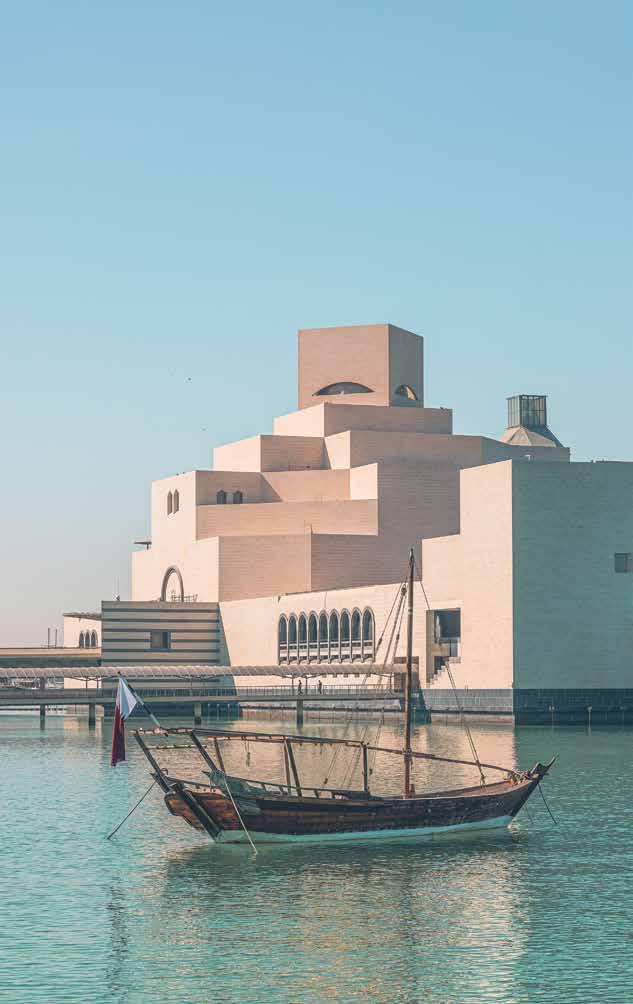
A / season 5 / fall & winter / / delight in being home & away /
/ season 5 / fall & winter / /
/
delight in being home & away


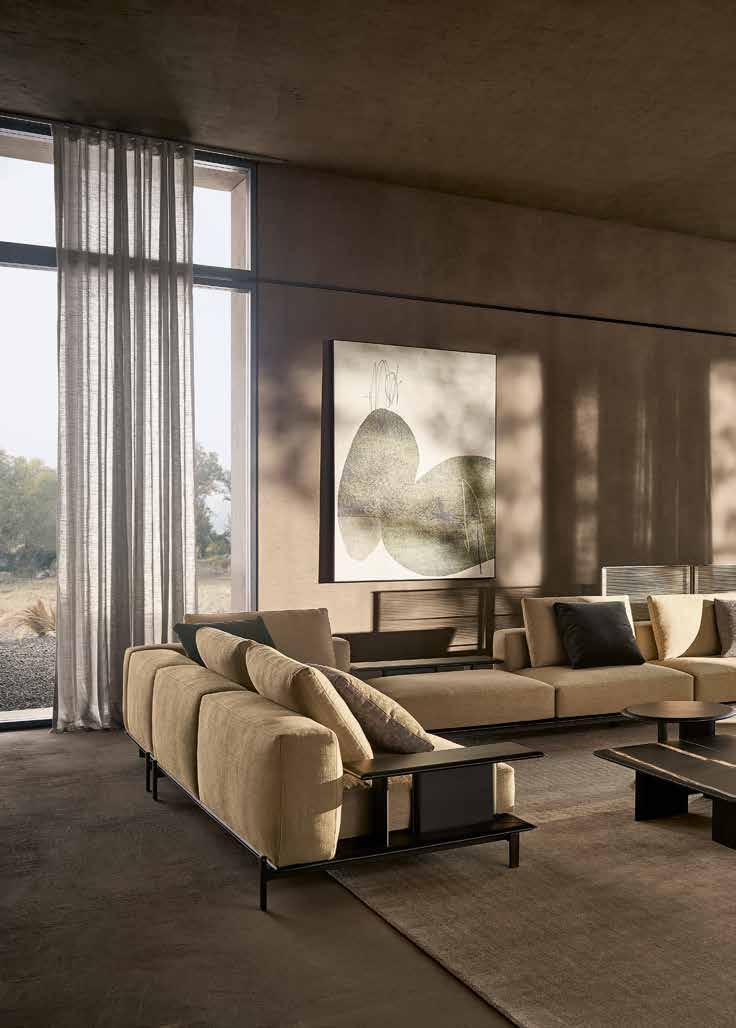
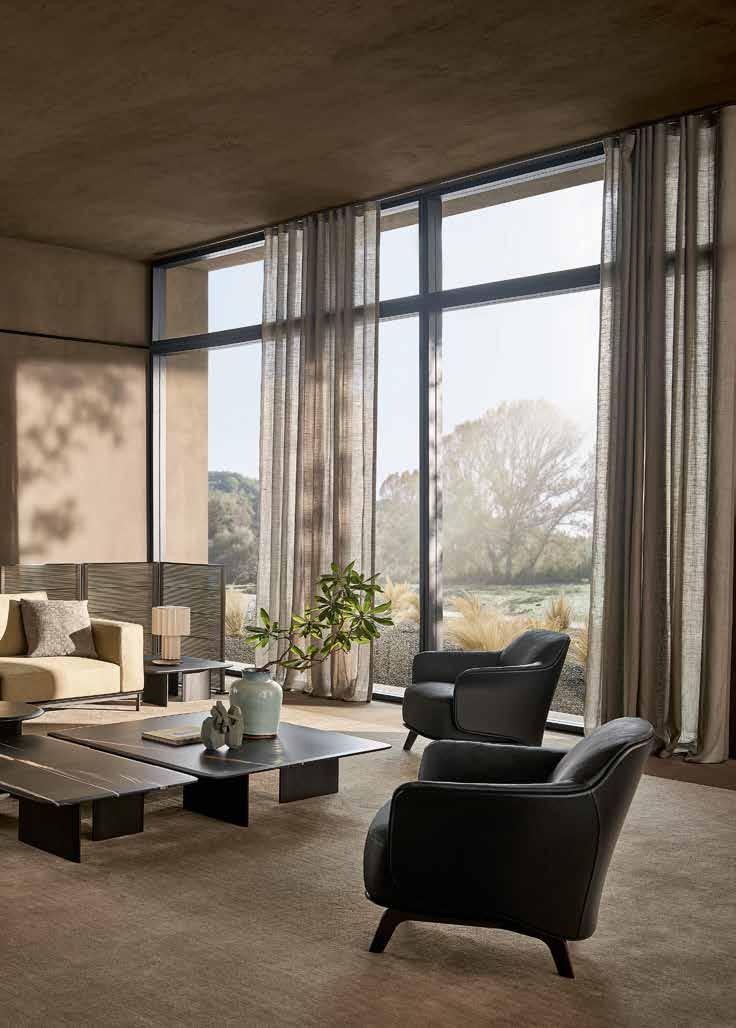
CEO & PUBLISHER
EDITOR’S LETTER
Jason Cutinella
GLOBAL EDITORIAL DIRECTOR
Brian McManus
VP GLOBAL BRAND
STORYTELLING
Marc Graser
DESIGNER
Eleazar Herradura
Operations
Joe V. Bock
CORPORATE AFFAIRS
Merri Gruesser
VP GLOBAL PARTNERSHIPS & DEVELOPMENT
Advertising
Mike Wiley VP SALES mike@nmgnetwork.com
Marriott International Residences
Amanda Altree VP, DEVELOPMENT & RESIDENTIAL BRAND MARKETING
Ayanna Wiggins DIRECTOR, GLOBAL RESIDENTIAL MARKETING
With every season of herein, we delight in being both home and away, and attempt to shine a light on ways to enrich readers’ lives. In this fifth issue, we hop around the globe in cities and places across Marriott International’s diverse portfolio of top shelf, luxury branded residential communities. Here, we head to Colorado to visit sculptor, artist, and poet of the soul James Surls, and the lush, calming greens of Portland’s Japanese Garden. We hop over to the beach and discover how to design homes with a water view, and to Atlanta to eat some of the fantastic food of the newlyreopened Atlas. Elsewhere we breathe in the inspiring architecture of Waikiki, and are wowed by the luxury and grandeur of Hamad International Airport in Doha, Qatar. We hope you enjoy this issue as much as we loved putting together these stories for you.
Published by:
NMG Network
36 N. Hotel St., Ste. A Honolulu, HI 96817
©2023 by NMG Network. Contents of Herein are protected by copyright and may not be reproduced without the expressed written consent of the publisher. Herein assumes no liability for products or services advertised within. Herein is a semiannual lifestyle publication of Marriott International
06
About the Cover
Counter Culture Studio by Chad Kilgore at Blue Hills. Round Top, Texas. Image by Melinda Ortley

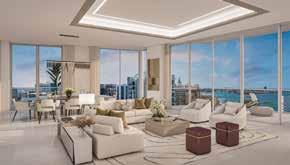


Broker Participation Welcomed and Encouraged. ORAL REPRESENTATIONS CANNOT BE RELIED UPON AS CORRECTLY STATING REPRESENTATIONS OF THE SELLER. FOR CORRECT REPRESENTATIONS, MAKE REFERENCE TO THIS BROCHURE AND TO THE DOCUMENTS REQUIRED BY SECTION 718.503, FLORIDA STATUTES, TO BE FURNISHED BY A SELLER TO A BUYER OR LESSEE. This project has been filed in the state of Florida and no other state. This is not an offer to sell or solicitation of offers to buy the condominium units in states where such offer or solicitation cannot be made. Prices and availability are subject to change at any time without notice. Images are artist’s renderings and may not represent the final building. Furnishings and fixtures are for display purposes and are not included with the residence. Actual improvements, including, recreational facilities and amenities, may vary from those shown and views may not be available from all units. PRESENTED BY The
Bayfront
Marriott International, Inc. or its affiliates
KT
which has not confirmed the accuracy of any of the statements
Next Evolution of Luxury Begins Introducing 78 Grand New Residences on Sarasota’s
Presentation Gallery Now Open at The Ritz-Carlton, Sarasota 1111 Ritz-Carlton Drive, Sarasota, Florida 34236 941.499.8704 | TheResidencesSarasotaBay.com The Ritz-Carlton Residences, Sarasota Bay are not owned, developed or sold by
(“Ritz-Carlton”).
Sarasota South, LLC uses The Ritz-Carlton marks under a license from Ritz-Carlton,
or representations made herein.
CEO & PUBLISHER
Jason Cutinella
GLOBAL EDITORIAL DIRECTOR
Brian McManus
VP GLOBAL BRAND
STORYTELLING
Marc Graser
DESIGNER
Eleazar Herradura
Operations
Joe V. Bock CORPORATE AFFAIRS
Merri Gruesser
VP GLOBAL PARTNERSHIPS & DEVELOPMENT
Advertising
Mike Wiley VP SALES mike@nmgnetwork.com
Marriott International Residences
Amanda Altree VP, DEVELOPMENT & RESIDENTIAL BRAND MARKETING
Ayanna Wiggins DIRECTOR, GLOBAL RESIDENTIAL MARKETING
Published by: NMG Network
Published by: NMG Network
36 N. Hotel St., Ste. A Honolulu, HI 96817
36 N. Hotel St., Ste. A Honolulu, HI 96817

About the Cover
Counter Culture Studio by Chad Kilgore at Blue Hills. Round Top, Texas. Image by Melinda Ortley MARKETING
©2023 - 2024 by NMG Network. Contents of Herein are protected by copyright and may not be reproduced without the expressed written consent of the publisher. Herein assumes no liability for products or services advertised within. Herein is a semiannual lifestyle publication of Marriott International
©2023 by NMG Network. Contents of Herein are protected by copyright and may not be reproduced without the expressed written consent of the publisher. Herein assumes no liability for products or services advertised within. Herein is a semiannual lifestyle publication of Marriott International
The Museum of Islamic Art in Doha, Qatar. Image by Visit Qatar
08

16
Colorado
HEAVEN IN A WILDFLOWER
To understand why worldrenowned artist James Surls chooses to make work in rural Carbondale, one must only take a look outside.
44
Los Angeles
LOS ANGELES IS WAITING FOR YOU
Spoil yourself from the beach to Beverly Hills.

hawai ‘ i
Waikīkī’s Inspiring Architecture | 62 image by john hook
28 Portland
JAPANESE MAGIC IN PORTLAND
A postwar tribute is no cultural relic, but rather one of the most enchanting places in a postmodern metropolis.
40
New York
NEW YORK CITY ON A FULL STOMACH CAN ALSO
BE A FEAST FOR THE EYES
There’s always something to discover in this dynamic metropolis with a constantly evolving landscape.
50 Global
BATHED IN BRILLIANCE
Harnessing natural light in beachfront home decor.
62
Hawai‘i
WAIKĪKĪ’S INSPIRING ARCHITECTURE
A stroll through the infamous tourist trap is actually an endless walk through time.
72
Mexico
A SERENE SANCTUARY ON MEXICO’S CARIBBEAN COAST
A stone’s throw from Cancún, Costa Mujeres offers a unique set of flavors—and a very different energy.
82
Atlanta
ATLANTA’S TOP CHEFS
After a summer of improvising, two stars of the scene in a southern food stronghold are ready to take the next step back at home.
96 Global
HOLIDAY EATS
What do different regions of the U.S. eat for Thanksgiving, Christmas, and beyond.
104
Qatar
DOHA’S NEXT ACT
Sustainability and art take center stage in the Middle East’s most exciting city.
112
Riviera Nayarit / Boston / Ho Chi Minh City / Hanoi / New Cairo
LES NOUVEAUX
Discover the newest Marriott International branded residences.
118
Dubai / Manila / Jeju / Utah
WELL AND GOOD
Explore some of the world’s most iconic destinations for coastal living.
120
Florida
JOY OF OWNERSHIP
Incorporating the excitement of the city is part of the design story for Bruce and David Starr at The Ritz-Carlton Residences, Miami Beach
each story in herein shares a location with one or more of these residences
10

Now Under Construction
Offered from $4,000,000
THE RITZ-CARLTON RESIDENCES, PALM BEACH GARDENS ARE NOT OWNED, DEVELOPED OR SOLD BY MARRIOTT INTERNATIONAL, INC. OR ITS AFFILIATES (“MARRIOTT”). DMBH RESIDENTIAL INVESTMENT, LLC USES THE RITZ-CARLTON MARKS UNDER A LICENSE FROM MARRIOTT, WHICH HAS NOT CONFIRMED THE ACCURACY OF ANY STATEMENTS OR REPRESENTATIONS MADE ABOUT THE PROJECT. ORAL REPRESENTATIONS CANNOT BE RELIED UPON AS CORRECTLY STATING THE REPRESENTATIONS OF THE DEVELOPER. FOR CORRECT REPRESENTATIONS, MAKE REFERENCE TO THIS BROCHURE AND TO THE DOCUMENTS REQUIRED BY SECTION 718.503, FLORIDA STATUTES, TO BE FURNISHED BY A DEVELOPER TO A BUYER OR LESSEE. DEVELOPED BY CATALFUMO COMPANIES EXCLUSIVE SALES AND MARKETING BY DOUGLAS ELLIMAN DEVELOPMENT MARKETING TheResidencesPalmBeachGardens.com TO SCHEDULE AN APPOINTMENT, CALL (561) 462-0205. SALES GALLERY: 4001 DESIGN CENTER DRIVE, SUITE 110, PALM BEACH GARDENS
THE ESTATE COLLECTION
The luxurious embodiment of sea and surf, The Ritz-Carlton Residences, Palm Beach Gardens deliver a new level of leisure—transforming fourteen acres of Intracoastal waterfront into an intimate enclave of 106 estate residences and private marina. A LIMITED OFFERING OF 3-, 4- AND 5-BEDROOM WATERFRONT RESIDENCES AND PRIVATE MARINA
The Height of Waterfront Living in the Heart of Palm Beach Gardens
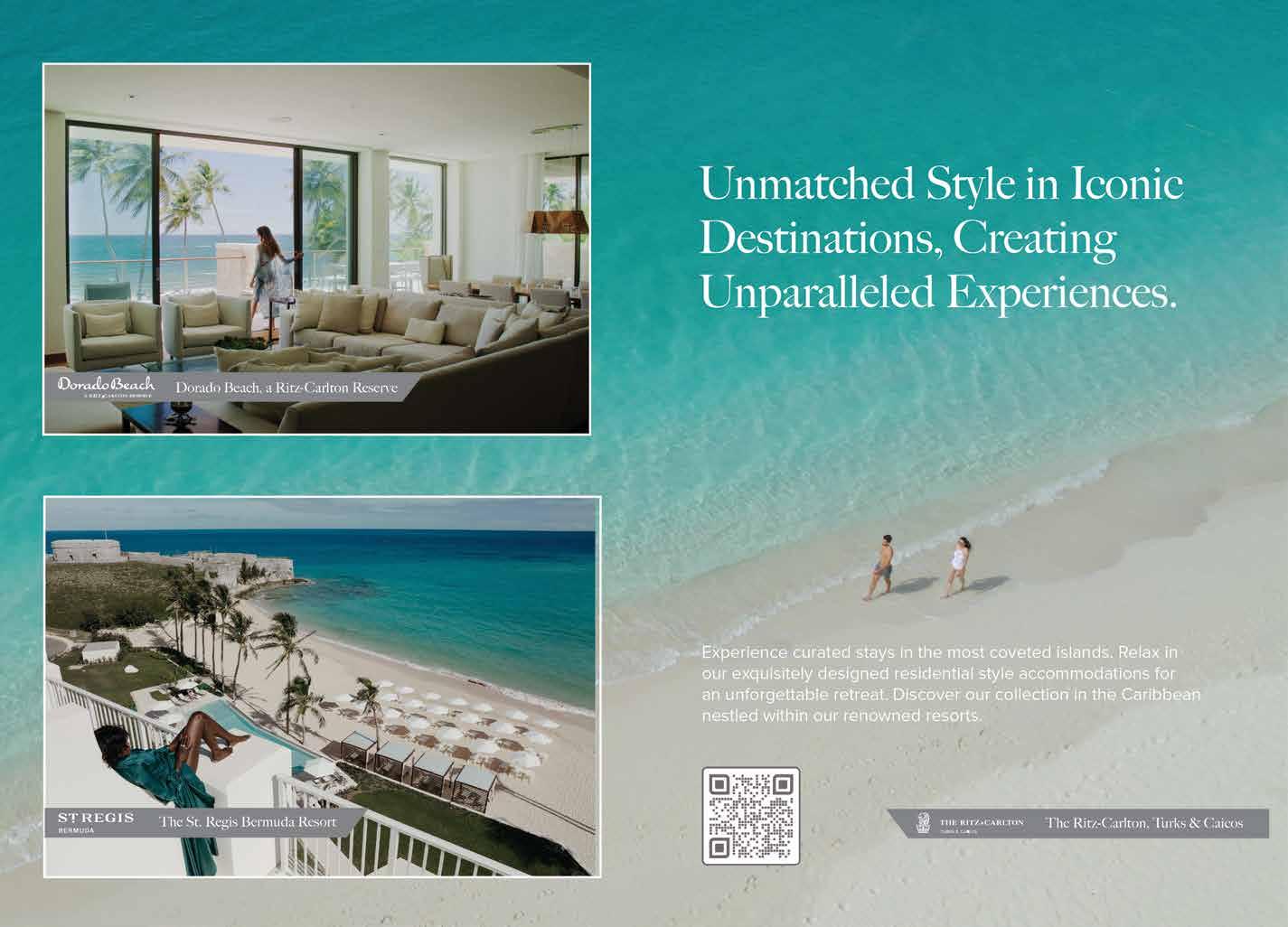

hello
A welcoming gesture
colorado / portland / new york / los angeles
image by tim aushunkas
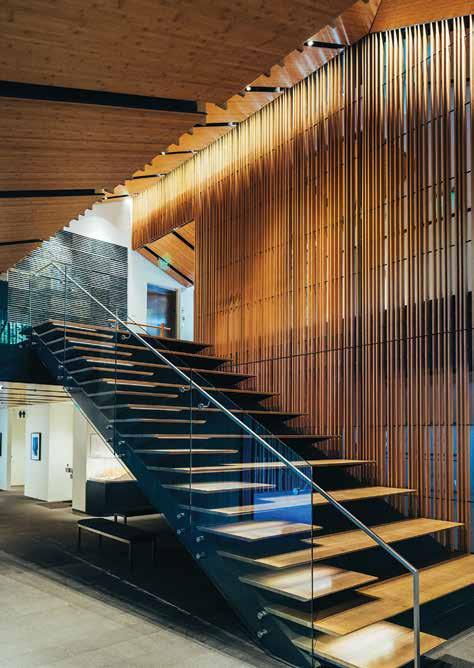
the azulejos of portugal 15
james surls chooses to make work in rural carbondale , one must only take a look outside
Heaven in a Wild Flower
James Surls doesn’t exactly fit the description of what you may think of when you picture an artist. No beret or round tortoise shell glasses. His look is more blue collar worker than nose-inthe-air sophisticate. That makes sense.
It’s early one morning on one of those cool days when summer and fall finally overlap, and I’m seated across the table from Surls— the beloved sculptor, poet, and visual artist based in Carbondale, Colorado. By “across
the table,” I mean “on a Zoom call.” Surls is at his other home in Texas, a 185-acre ranch in the Splendora woods northeast of Houston. He is there clearing trees and manicuring a path through the forest for an art show he and his wife, artist Charmaine Locke, are planning. He is eager to talk to me about his connection to all landscapes and nature, and about his love for Colorado’s Roaring Fork Valley.
“The worst view out there is about a ninenine,” he tells me with an endearing drawl
compiled by paddy o ’ connel images by benjamin rasmussen and trevor triano
to understand why world - renowned artist
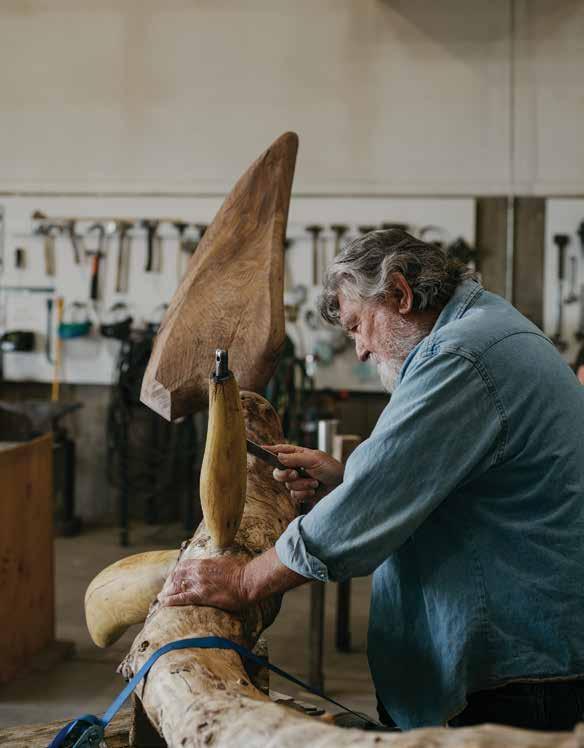
global | design 17 colorado | design

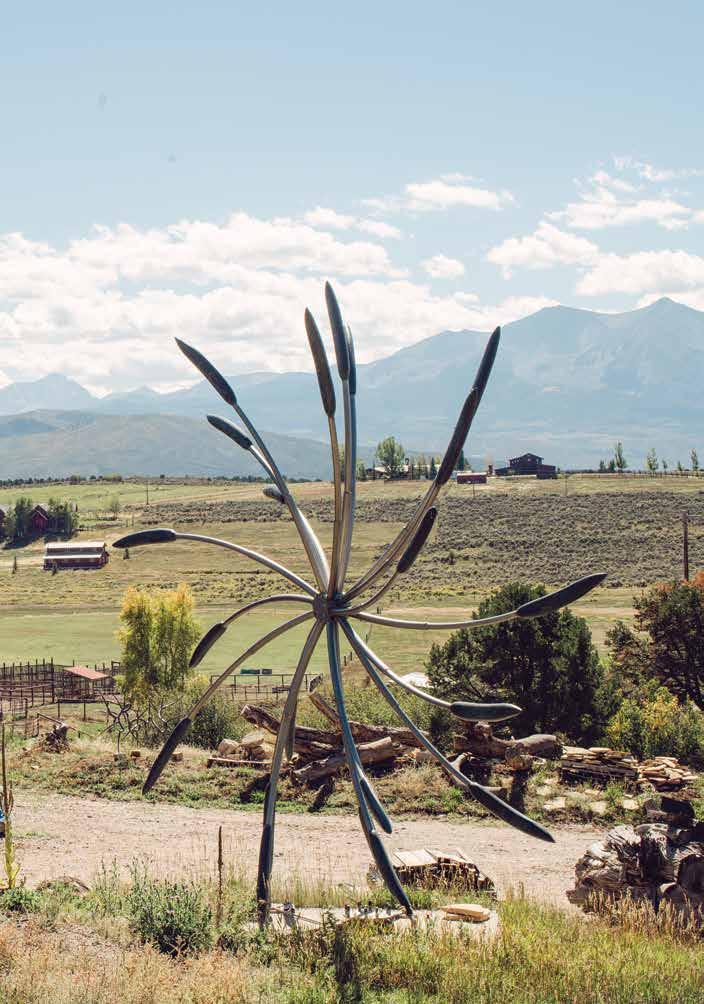
that falls out of the side of his mouth like a body sinking into a comfy chair at the end of a long day outdoors. “There’s a few tens here and there and yonder, but my God, there’s not a bad view. If you don’t like living in the Roaring Fork Valley, it’s your fault.”
Surls has lived in the RFV since 1997, but has kept his Texas home, studio, and roots intact. With his white hair and beard and tender, childlike eyes that belie his 80 years, he has the rugged look of Ernest Hemingway but the smile and warmth of a mall Santa, and the way he speaks about his art is just as approachable. “It revolves around a sense of place,” he tells me. “I say you have to breathe deep the river, you have to breathe deep the mountain, you have to inhale the atmosphere and the sensibility of where you are.”
What Surls exhales is shocking and lovely. He has been described as a buckeye surrealist master. I get a firsthand, kickyou-in-the-gut experience with his work when his daughter Eva, Surls’ manager and personal assistant, gives me a tour of his Carbondale studio. Noting my visceral reaction to the spectacle inside, Eva responds, “Yeah, I know.”
Surls’ latest piece looms before us. Enormous wooden flowers sprout from steel stems that Surls has affixed to a 125-yearold Northern California redwood burl the size of a Tuff Shed. Their petals vary in size, ranging from the length of an arm to nearly that of a helicopter rotor. I ask Eva about her father, but I’m distracted by the behemoth that towers 20-plus feet above us, dwarfing its surroundings. The studio itself is a sight to behold: Framed prints are on display beside chains, pneumatic lifts, and
welding implements; sculptures hang from I-beams and fill the tabletops alongside hatchets and horse files. Yes, it is a studio, but it is a garage shop by any other name.
The combination of order and creative calamity inside the studio is Surls’ character personified. He keeps the same schedule and wears the same work boots, worn blue jeans, red suspenders, and Wrangler shirt every day, a product of the work ethic and sense of routine instilled in him as a boy, when he was tasked with rising before the sun to milk the cows at his childhood home in Texas. As I stand staring at the wood and steel wonders surrounding me in his shop, I recall what Surls told me about his creative process. “Just go to work, period,” he says. “I make art regardless of where I am. It doesn’t make any difference. I could be in a field out in Kansas and I still make art.”
When I admit to Eva that her father’s bluecollar approach makes me like him and his artwork even more, she smiles like I am telling her something she has heard many times before. “People resonate with my dad and his work because he functions outside the norms of the art world,” Eva says. “He’s just a working guy. If you saw him down at the Co-Op in his pickup truck, you’d never think he is a world-class artist. You’d think he was a rancher or a plumber. But you come here, and you know why he’s shown at the Guggenheim and the MoMA.”
You can’t help but feel something when confronted with a James Surls piece. It is the same reaction you might have when encountering the jaw-dropping magnificence of the valley where he lives and works. Somehow, with his wood and
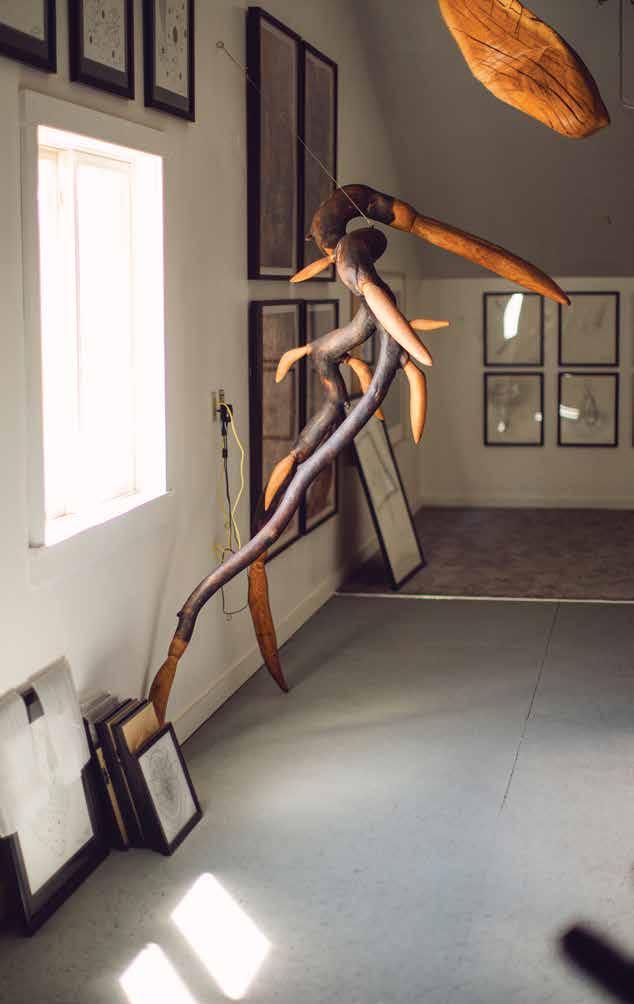
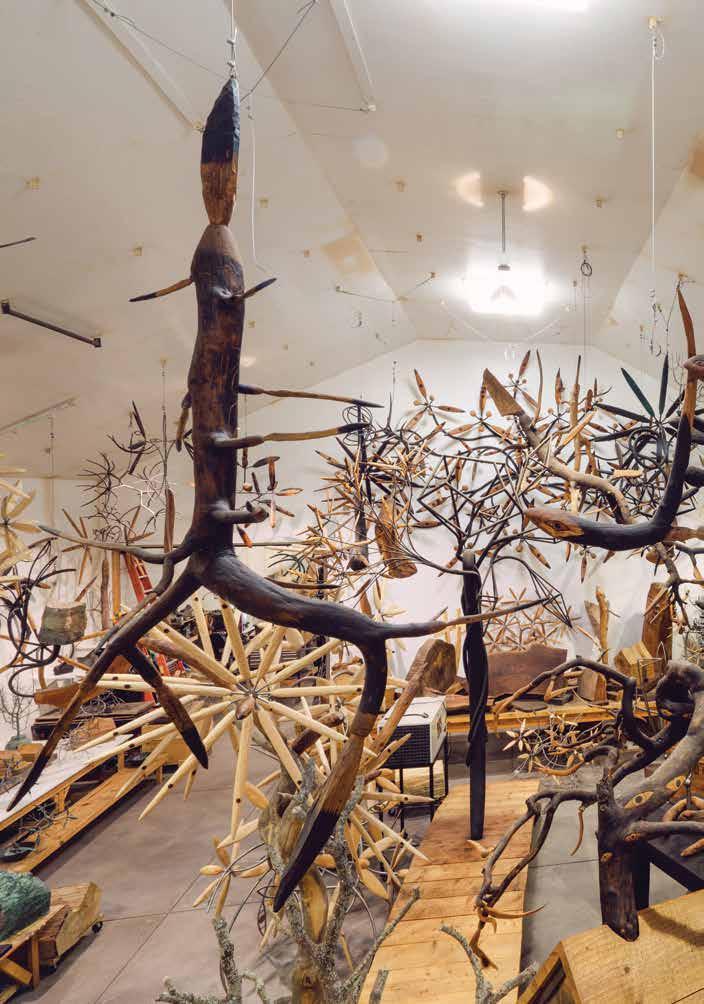

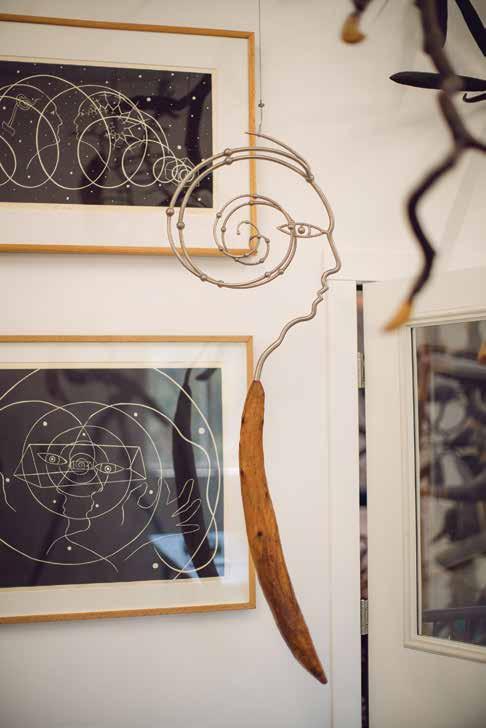

his steel, his poetry and his hands, Surls captures this sublime landscape in his work.
“From our kitchen window, we can see the top of Sopris,” Surls says. “We can see McClure Pass. We can see Chair Mountain, the tip of Mount Daly and Capitol Peak. I can look up the valley and see a thunderstorm coming from Aspen, or one coming through the Crystal Valley. If that doesn’t affect you, then you’re blind. You’re not breathing deep where you are. Well, I am totally there. I conjure from the trees, the rivers, the rocks. That is my muse. That’s my source.”
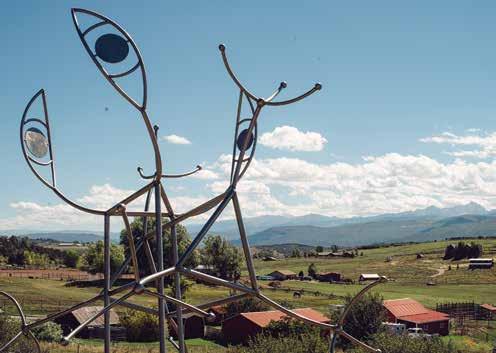
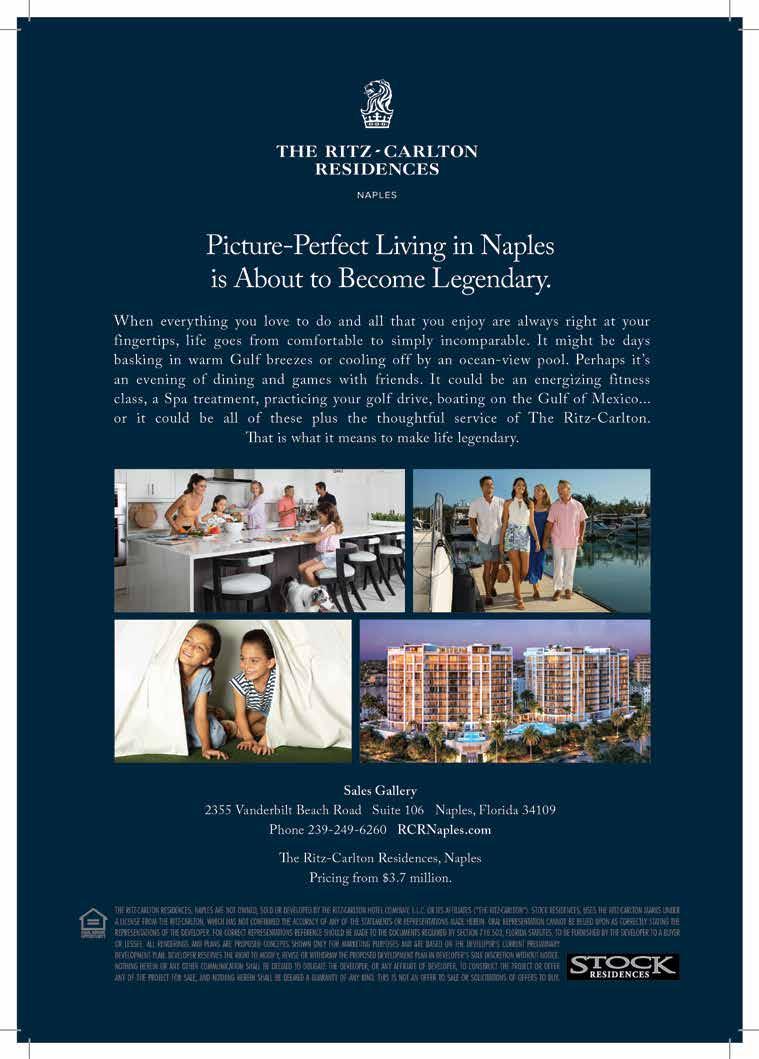
Japanese Magic in Portland Magic
No single person gets the credit for the idea to build a Japanese garden in the southwest hills of Oregon’s largest city. In one account or another, an opaque “community” of supporters banded together about 60 years ago to create the serene space in Portland that is now widely considered the best such garden anywhere in the world—outside of Japan, of course.
It’s fitting that there is no heroine or hero in the rich history of the Portland
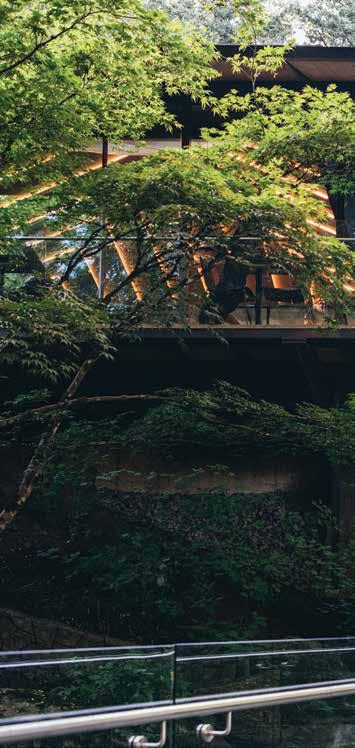 text by winston ross images by tim aukshunas
text by winston ross images by tim aukshunas
a postwar tribute is no cultural relic , but rather one of the most enchanting places in a postmodern metropolis
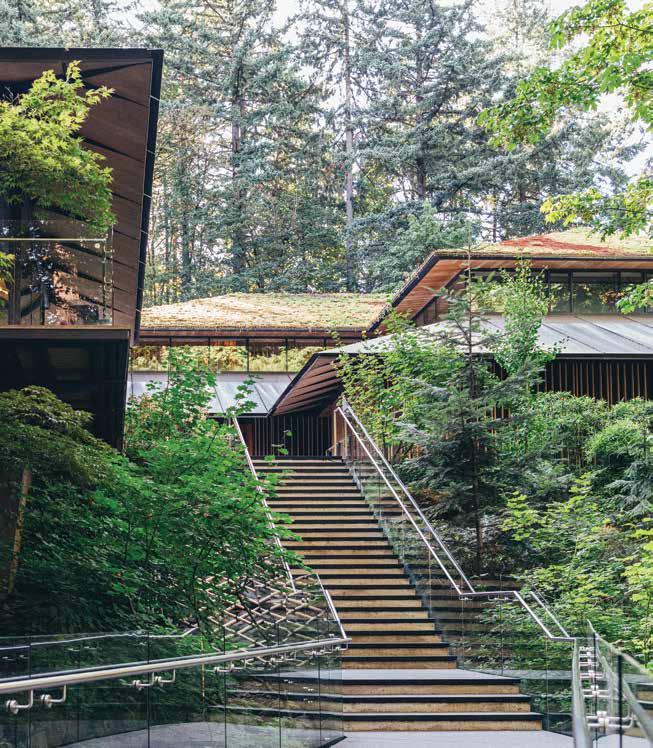
29 portland | garden


Japanese Garden. This is a community, after all, of no less than eight different styles (most gardens in Japan stick to one) and dozens of varieties of trees and plants. Magnificent stone lanterns—like the two-ton, five-tiered, century-old pagoda—and ornamental rocks are tucked humbly here and there, none drawing too much attention. American and Japanese flora and fauna, from bamboo groves to vibrant azaleas, mingle quietly on the site’s 12 acres. There are no celebrities.
Some of the 400,000 annual visitors who climb the winding path to enter the garden may find a “boss tree,” as Garden Curator Hugo Torii describes it—a standout species that can’t help but draw our gaze, the locus from which everything else in a person’s periphery might flow. But these bosses’ reigns are impermanent. Trees grow sick, and grow old. The garden’s majesty relies on all of its residents, from the quiet pebbles raked into concentric circles in the Standing Stone Garden to the colorful koi swimming this way and that at the base of Heavenly Falls. It’s this collaboration, from the soft moss lining the garden grounds to the spectacular opening to Mt. Hood, Portland’s Mt. Fuji, that makes this place so special.
Conceived in the late 1950s and launched in 1963, the non-profit garden had to overcome some hefty obstacles to become what it is today. The grounds housed the old Portland Zoo beginning in 1925, its animals largely languishing on concrete blocks as visitors ogled from above. The zoo departed for a bigger parcel in 1959, leaving the site in Washington Park abandoned—a barren brownfield.
The idea was then (and is now) much more than just to create a pretty place to stroll. It’s a gorgeous physical manifestation of
healing two decades after a world war that left two cultures traumatized and afraid of one another. The founders of this place sought to display a tranquil representation of Japan as a means of quiet diplomacy. While locals were not uniformly welcoming at first—some even descended into ugly protest—-it’s clear now that this is not a place that inspires conflict.
“It has proven that a public garden can make a transformational impact on society,” says garden spokesman Will Lerner. “This is among the foremost Japanese cultural organizations in the world.”
Professor Takuma Tono of Tokyo Agricultural University was the Japanese landscape architect hired to create the place, which he did with the utmost attention to detail. When building the waterfall that tumbles into the bear grotto-turned Strolling Pond, Tono was known to turn his back to it, to listen without any visual distractions to the sounds of the water cascading across the rocks. When dissatisfied with the sound, he’d have the workers rearrange the rocks, again and again, until it was just so.
The garden, with an original footprint of 5.5 acres, expanded in 2017 to 12 acres, a $33.5-million project led by the worldrenowned architect Kengo Kuma on grounds that are constantly, thoughtfully maintained, manicured, and reimagined. By its very nature, it demands constant change. The original camellias bushes from 19 Japanese cities had to be replaced after insect spray required by U.S. customs killed them off. The first tree, a Japanese maple from a yard in Southwest Portland, died after it was set in a hole with bad soil.
“You have to be brave to make these decisions,” says Torii of the individual
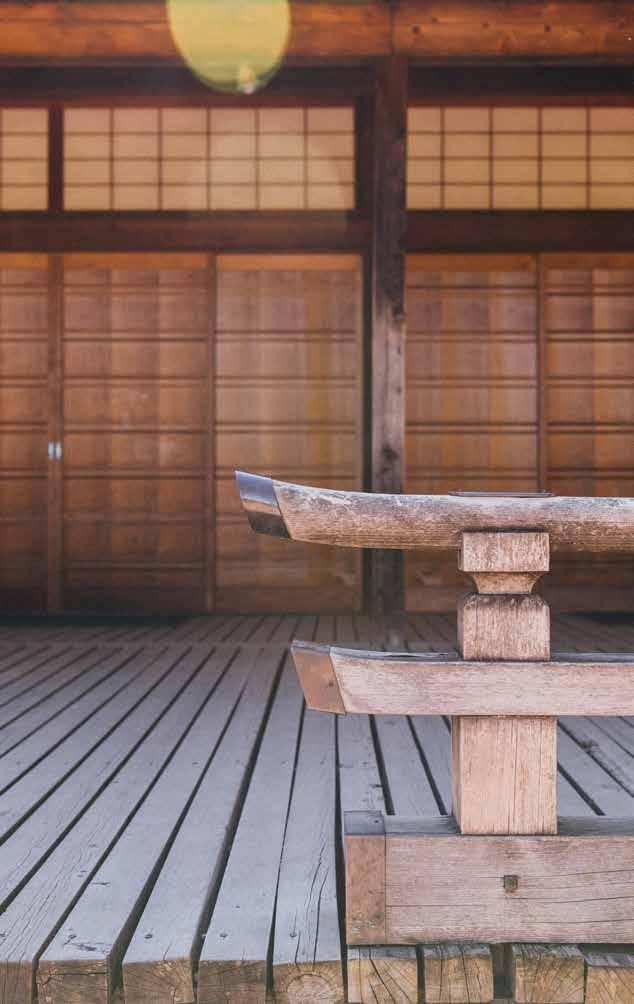
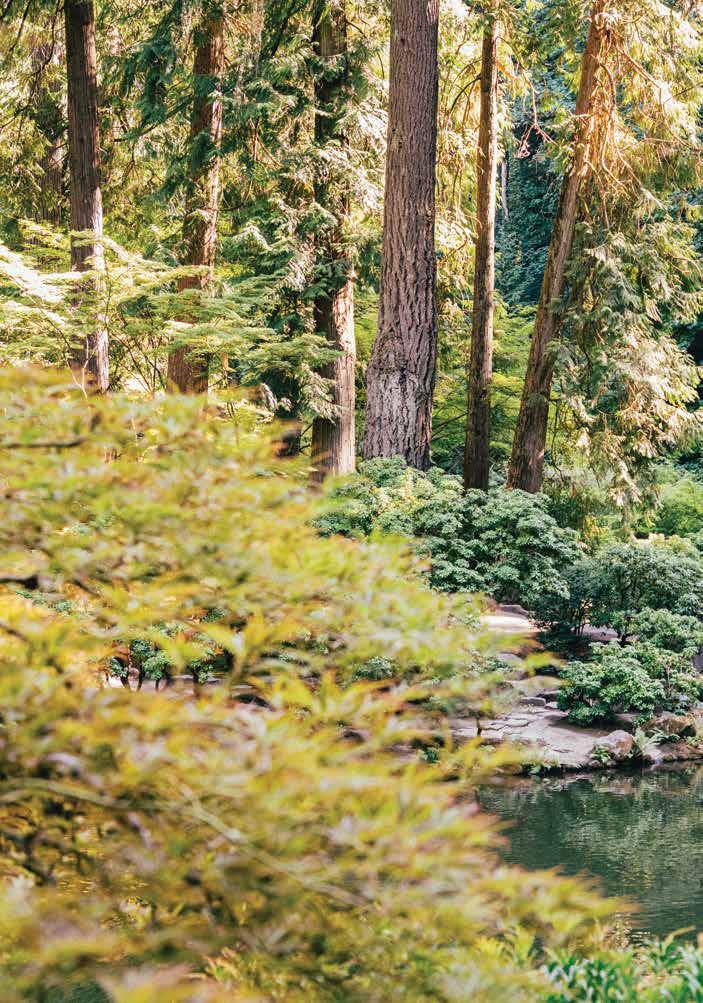
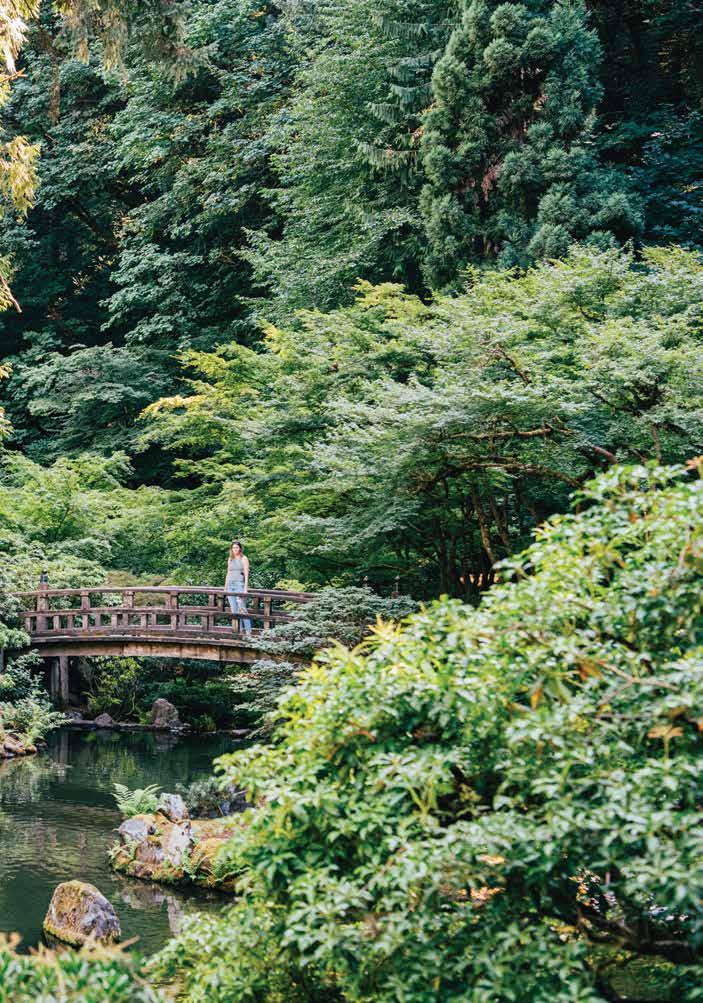
choices about when a tree needs to be replaced. “Even with trees that have been there for decades, there’s no way out. It has to change.”
One of Torii’s favorites is the large maple that lies in the foreground of the flat garden, “the only tree I make sure I prune myself,” largely because it requires an unusual approach: “Some trees you can work from the outside to keep in proportion, this one you have to work from the inside.” Next to that tree sits a rarity from Kyoto called a kibune; it’s one of the seven special stones throughout the garden. Torii worries that the stone has become shrouded by the plants around it, he says: “It’s not so happy.” It’s time for a change. “We have to be ready to tell a new story,” he adds.
Behind a weeping cherry resides another set of Torii’s favorite residents: a collection of Japanese black pines and shore pines that represent cultural exchange, as these trees come both from America and Japan. Meanwhile, inside the Kashintei Tea House, which was meticulously built in Japan, disassembled, shipped to Oregon, and then reconstructed in Portland, partner organizations hold elaborate tea ceremonies. Lerner loves the Natural Garden, which winds this way and that at the bottom of a hill. “It’s always a conversation between you and the garden,” he explains. “Your interpretation of what you see is correct.”
Today, the garden flourishes, and its cultural diplomacy has found contagion in
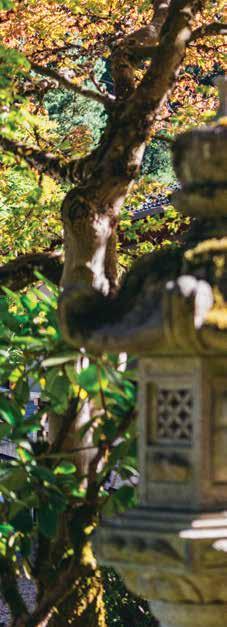
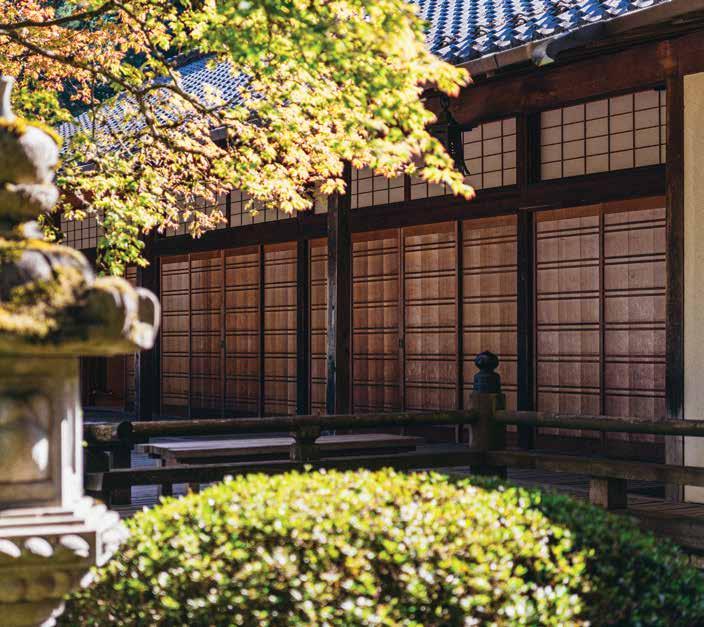
37
the 250 events that take place each year—and in the establishment of the Japan Institute, a sibling organization that expands on the garden’s programming and partnerships via international forums on art, peace, and nature. That new endeavor lies on a 3.65-acre campus three miles from the garden, but it’s the original site that has legions of fans.
Some journey here each year, hoping to time their arrival to the perfect day when fall colors explode on one of those “boss” trees—a lace-leaf Japanese maple is known simply as “The Tree”—so that they might capture an iconic photograph of its emblazoned leaves and twisted branches at just the right angle.
The garden is beautiful dry or wet, in Oregon’s long, rainy season or its short, sunny one. Visitors would do well not to overthink a foray; the history is in their favor.
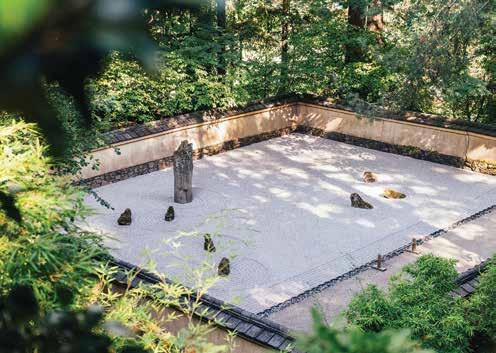

THE INFINITE BEACH
Exquisite Oceanfront Residences From $5.6 Million
Ideally situated along 435 linear feet of pristine beach and immersed in unforgettable ocean views, The St. Regis Residences, Sunny Isles Beach, Miami, represent the height of exquisite living. Where skyline-defining architecture, visionary style, flawless craftsmanship, and signature St. Regis service and rituals create a singular experience of effortless luxury in a glamorous setting.
Miami are not owned, developed or sold by Marriott International, Inc. or its affiliates (“Marriott”). La Playa Beach Associates,
uses the St. Regis marks under a license from Marriott, which has not confirmed the accuracy of any of the statements or representations made about the project. Oral representations cannot be relied upon as correctly stating representations of the developer. For correct representations, make reference to the documents that are required by section 718.503, Florida statutes, to be furnished by a developer to a buyer or lessee. The developer is la playa beach associates, llc which has a right to use the trademark names and logos of fortune international group and chateau group. This is not an offer to sell, or solicitation of offers to buy, in states where such offer or solicitation cannot be made. The rendering contained herein is an artist impression, conceptual interpretation, proposed only and merely intended as illustration. No guarantee is made that the described features, services, amenities or facilities will be available or built. Developer reserves the right to make any modifications, revisions or withdrawals in its sole discretion and without prior notice. All improvements, design and construction are subject to first obtaining permits and approvals for same by the relevant authorities. DBOX t. 786 485 1809 srresidencessunnyislesbeach.com Visit The Oceanfront Sales Gallery 18801 Collins Avenue Sunny Isles, FL 33160
The St. Regis
Residences,
Sunny Isles Beach,
LLC
New York City on a Full Stomach Can Also be a Feast for the Eyes
For seven days and seven nights, the Superiority Burger focaccia dough sleeps. The week of rest gives the golden, lavishly olive oiled bread an interior that’s honeycombed with bubbles, all the better for stuffing with Cooper Sharp and all-daybraised collard greens that spill out the sides of the sandwich like a dark green ruffled skirt. At this, the second, super-sized re-opening of Superiority Burger, perhaps New York City’s most unstoppably buzzy restaurant, the eponymous veggie burger gets marquee billing, but it’s the collard greens melt you’ll remember long after you finish the last spoonful of roasted pluot sorbet. Flat out, it’s one of the most astonishingly delicious things to eat in a city full of astonishingly delicious things to eat.
People come to New York for many reasons, few more noble than feasting on a diverse, dynamic restaurant scene that thrills from blossom-bedecked cakes to Roman-pedigreed pastas to magic croissants cloistered away like horcruxes in a nondescript office tower. If you know, you know.
These and countless other treasures live in Lower Manhattan, a restaurant-dense quilt
encompassing neighborhoods like thoroughlyestablished SoHo and having-a-moment Alphabet City. It helps if you know where to go and what to do. For food lovers who travel to eat, it also helps if you’re carrying the Marriott Bonvoy Brilliant® American Express* Card— the 3X Marriott Bonvoy Points earned for each eligible dollar spent at restaurants worldwide* goes a long way.
You’ll want to set up camp for your culinary adventures somewhere central, somewhere with style. The New York EDITION rises from the eastern flank of Madison Square Park, just a mile above the limit of Lower Manhattan. Stepping off the frenetic street into the lobby is like passing through an air-lock—instant decompression via an understated timeless aesthetic: Venetian plaster walls, original restored wood floors, and fabrics and leathers in soft tones of oatmeal, silver and white which create a light and airy feel that is both warm and inviting. Even the guest rooms here exude modern sophistication with dark walnut headboards, and Le Labo bath products. And since Marriott Bonvoy Brilliant® American Express® Card comes with Marriott Bonvoy Platinum Elite Status, you’ve scored a complimentary upgrade to a suite
there ’ s always something to discover in this dynamic metropolis with a constantly evolving landscape text by adam erace paid content by american express and marriott bonvoy
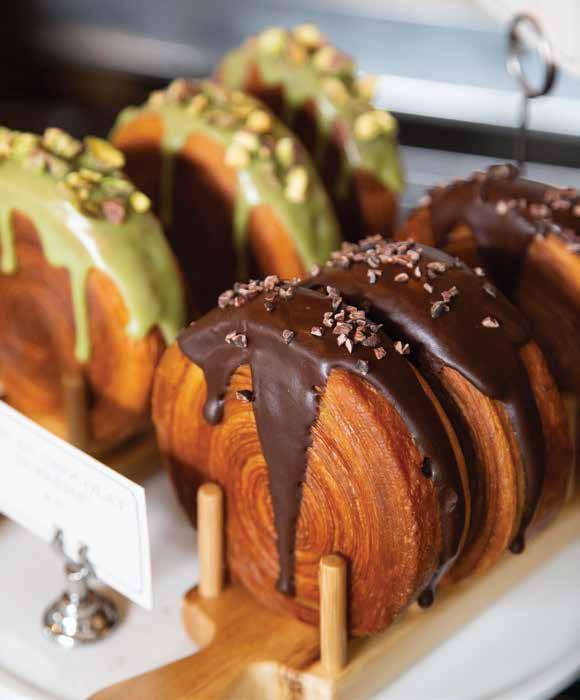
the
41 new york city | promotional
profiteroles at lafayette
with late check-out (subject to availability at select properties and booked with a Qualifying Rate)*.
And not that you’re looking to venture Uptown this trip, but just something to keep in mind for next time: If you book two nights at The St. Regis New York, The Ritz-Carlton New York, Central Park or new The Ritz-Carlton New York, NoMad, the Marriott Bonvoy Brilliant® American Express® Card offers up to $100 property credit for qualifying purchases when booked direct under a special rate* you can use on all the little indulgences that make a vacation feel like a vacation. Midnight turkey club room service, muscle-recovery massage, a snack from the minibar—go crazy.
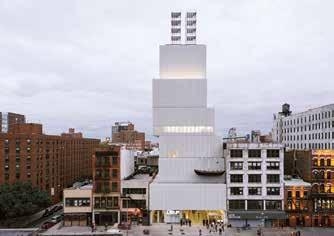
Grab the train or walk back downtown, stopping through the famed Union Square Greenmarket on your way to another bazaar, Canal Street Market, on the SoHo-Chinatown border, where on weekends you can shop knit hoodies and fancy candles from indie makers. Three blocks away is Lafayette, housed in a grand brick building with arched doors, loft windows and a sidewalk patio canopied in blue umbrellas. Ask for a cozy corner banquette and get into the French menu: Breton prawns duck confit with rhubarb,
brisket burger with Djonnaise, caramelized onion, and Comté. Save room for the profiteroles drowned in chocolate sauce.
Now that you’re back on this side of the island, perhaps a quick break from eating? Packed as Lower Manhattan is with smart and interesting restaurants, the arts and culture scene here is also electric. Sure, everybody knows about Uptown institutions like the Met and Museum of Natural History, but you’ll probably be the only person in the group chat who can wax poetic about the captivating illustrations at the Drawing Center, the beloved gallery that partners with students of four local public schools for hands-on workshops.
The New Museum on Bowery and the Whitney in the Meatpacking District, meanwhile, are more traditional locales for modern art lovers and feature cutting-edge collections and exhibitions. Both command a visit, though the slight edge must go to the Whitney. The museum’s old restaurant is becoming a flagship location for Frenchette Bakery and both the legendary sweet and savory fare they’ve come to be so well known for.
It’s just under two miles walking from the Whitney, through the West Village and NoHo, to Superiority Burger. One Frenchette twicebaked pistachio croissant per mile seems about right, enough to simultaneously satisfy and whet an appetite. The punk diner is already jangling like a pinball machine when you get there and survey the menu: collard greens sandwich, of course, but maybe also the burnt broccoli, and the roasted sweet potato with pickles and labneh, and a date shake or boysenberry malt to wash it down. What, too much? In New York, there’s no such thing.
* to learn more about marriott bonvoy brilliant ® american express ® card visit their website : https :// www americanexpress com / us / credit - cards / card / marriott - bonvoy - brilliant /
* terms apply see more at https :// apply americanexpress com / marriottbonvoymclp 59 /

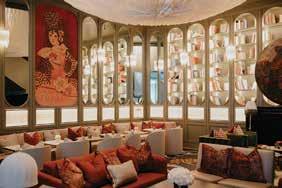
above : the st regis new york left : the bazaar by josé andrés at the ritz - carlton new york , nomad
opposite page : chris burden , twin quasi legal skyscrapers , 2013 ; chris burden , ghost ship , 2005 . © chris burden / licensed by the chris burden estate and artists rights society ( ars ), new york building : new museum of contemporary art , 2013 photo : dean kaufman
43
Los Angeles Is Waiting for You
Sometime in the 1970s, a hunter from Ohio went to France. There, in the homeland of haute cuisine, he purchased a duck press, an arcane contraption designed to wring the delectable juices from roasted and carved fowl in a circa-1800s preparation called canard à la rouennaise— duck in the style of Rouen, the wealthy capital of Normandy. The hunter brought the antique appliance back to America and threw a duckpress f ête every year until he grew old and the tradition became burdensome. Today through a bit of digital whisper-down-the-lane, the vintage press is enjoying a sunny new life in Los Angeles, a few blocks from the beach at Santa Monica’s Pasjoli, a shimmering French restaurant swaddled in first-class comforts like some rare melon at a Tokyo department store.
With its showcase of aristocratic Gallic dishes (heavenly scallop quenelles, billowing chocolate soufflés) and interactive tablesidees this feel overly presentations, Pasjoli is not the stereotypical restaurant most visitors imagine when they think of the tacos-andwellness wonderland that is L.A. You’re not most visitors, which is why you’ve already preordered that duck. Served in two courses—a salad with crisped confit legs precedes the
sliced roasted breasts glossed with a tableside sauce made from Cognac, red wine, and the pressed jus—it’s wildly delicious and deliciously subversive. That’s L.A. in a nutshell.
You can make that nut a pistachio, at the Santa Monica Farmers Market. Plain, salted, or spiced, Santa Barbara Pistachio Company’s organic emerald kernels make incredible edible souvenirs from an L.A. trip. Find them at the Wednesday market on Arizona Avenue, a sun-splashed runway of tables stacked with sticky dates and citrus pyramids, farmers extolling the virtues of their strawberries and divers excavating fresh uni from spiky urchin globes. Nearly every producer accepts credit cards, a perfect opportunity to use your Marriott Bonvoy Brilliant® American Express® Card and earn 2x Marriott Bonvoy® points per dollar spent on eligible purchases.*
Not visiting L.A. on a Wednesday? The Santa Monica market also runs on Saturdays at this location, with a supplemental Sunday market on Main Street, one block from Pasjoli. For all the talk of traffic-traffic-traffic, most visitors are shocked to find the certain neighborhoods of the metropolis can be pleasantly walkable. But you take the road
paid
spoil yourself from the beach to beverly hills
text by adam erace
content by american express and marriott bonvoy

45 los angeles | promotional
the pasta laboratorio at funke by evan funke
less traveled, which is why you chose to base down by the beach, at the chic Le Méridien Delfina Santa Monica, where the automatic complimentary Platinum Elite status from the Marriott Bonvoy Brilliant® Card unlocks a complimentary upgrade (subject to availability at select properties when booked with a Qualifying Rate.)* to one of the hotel’s spacious, sapphire-splashed suites. Some boast balconies with Pacific views, though you can get a much closer look by walking from the hotel to the sand in mere minutes.
Clichéd as it might sound, Beverly Hills is another perfect place to drop your bags in L.A. Compared to other ultra-high-end residential enclaves, this fabled cloister feels almost quaint with its Spanish architecture and
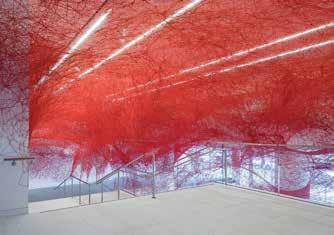
secret gardens, and the location is extremely convenient, roughly halfway between the beach and Downtown. The SLS Hotel, a Luxury Collection Hotel, Beverly Hills, is right on the neighborhood’s edge. You can see and be seen at the enviable rooftop pool, or simply spy the ocean in one direction and Hollywood sign in another. The rooftop pool offers spectacular views of the city’s storied neighborhood, making this hideaway an ideal spot. And as a benefit of the card, you receive 1 Free Night Award every year after your
Card renewal month. The Award can be used for one night (redemption level at or under 85,000 Marriott Bonvoy® points. Certain hotels have resort fees.)* making adding additional night to your stay an easy decision.
Staying in either Santa Monica or Beverly Hills puts you less than 20 minutes from some of the best art institutions in the city. An intricate, vein-like installation of scarlet yarn makes the new lobby of the Hammer Museum feel like the chamber of a massive heart, and the galleries and gardens beyond are treasure rooms of contemporary painting, drawing, and sculpture. Heading up into the hills of Brentwood, The Getty is a worldclass magnet of art and architecture with a sweeping view of L.A. Medieval illuminated manuscripts and ornate Swiss clocks, French tapestries and engraved gems, Degas sketches and Van Gogh’s Irises all live within the Getty’s galleries, though the oldest works in the collection are hidden in the ample gardens: ancient fossils revealed in the travertine stonework.
Take the back way back to Beverly Hills, following the serpentine curves of Sunset Boulevard to Canon Drive. Just across Santa Monica Boulevard is Funke, maestro Evan Funke’s jaw-dropping new restaurant housed in a circa-1930s Art Deco building. Complete with a 20-foot-tall, glass-encased pasta lab, it’s the birthplace of innumerable, impeccable orecchiette, tagliatelle, and agnolotti del plin. Reservations are in high demand, but those in the know can head upstairs to first-comefirst-served Bar Funke, the rooftop terrace for a spritz and house-baked focaccia. It’s walk-in only, and a stool at the stunning rose-quartz bar is waiting for you. So is Los Angeles.
* to learn more about marriott bonvoy brilliant ® american express ® card visit their website : https :// www americanexpress com / us / credit - cards / card / marriott - bonvoy - brilliant / * terms apply see more at https :// apply americanexpress com / marriottbonvoymclp 59 /


above : sls , a luxury hotel collection hotel , beverly hills rooftop pool deck left : pasjoli opposite page : hamner .- “ hammer projects : chiharu shiota , installation view , hammer museum , los angeles , march 26, 2023 – august 27, 2023 courtesy of the artist photo : jeff mclane image © ars , new york , 2023 .”
47
home
A haven worth savoring
global / hawai ‘ i / mexico
image by nicholas ferris
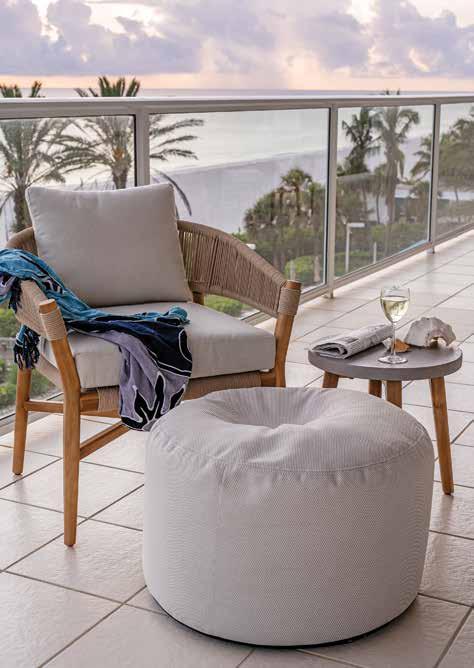
49
design by jaime walters
Bathed in Brilliance
Natural light is everything. If you live in an oceanside villa with floor-to-ceiling windows or an urban garden unit apartment with limited views, you know how much it matters. Maximizing the sunlight in your home is essential. It can open up the whole space and make you feel better about where you live. More importantly, study after study has shown natural light’s physical and mental health benefits which include
 text by josh terry
text by josh terry
harnessing natural light in beachfront home decor
images by nicholas ferris
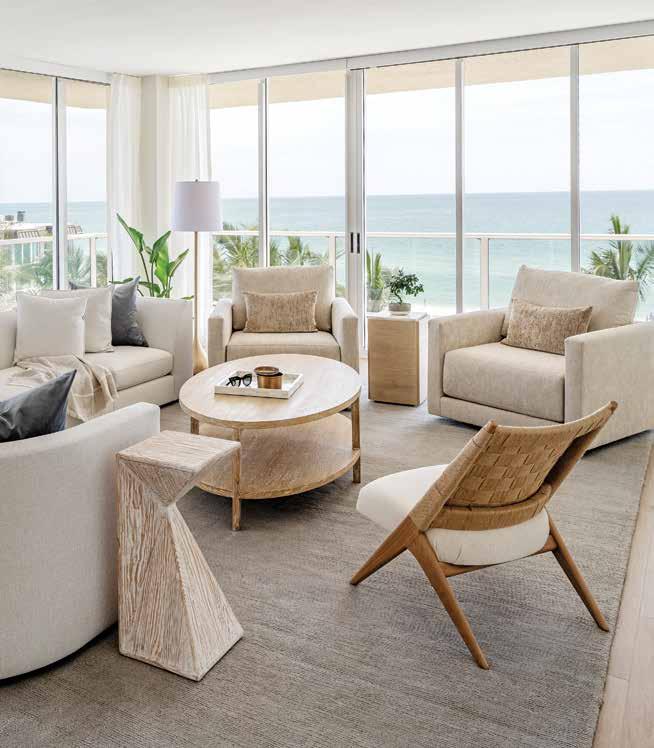
51 golbal | interior
everything from improving sleep, Vitamin D storage, your vision, your productivity, and your overall mood. Your daily life needs to let the light in and if you have a vacation home, your beachfront decor should do everything it can to make the sun the center of the space.
Tracee Murphy is the CEO and Principal Designer of the Sarasota, Florida-based interior design firm Trade Mark Interiors and she knows a lot about the health benefits of natural light. After all, her background is just as rooted in psychology as it is in interior design. “I originally started my career in the psychology field and transitioned to design after purchasing my first home,” she says. “After 23 years in business, we are still passionate about design and now incorporate principles of psychology in all of our work. We need to be sure we are creating spaces that speak to how our clients feel. Color is one way we accomplish this.”
On Trade Mark Interiors’ website, the business offers a download called “The Psychology of Color” that is meant to guide prospective clients through how “Color creates powerful psychological and physical effects.” The digital booklet gives detailed psychological profiles of each color and best practices for utilizing these hues in your home. If you’re thinking of incorporating blue into your space, they write that it’s “Great for bedrooms & bathrooms.” When it comes to beachfront properties, Murphy says color is their main tool

gilded accents bounce light around the room " says designer jaime walters here , a bedroom in a beach - front sarasota luxury condo decorated by walters

53
for enhancing design in the form of fabrics, paints, and hard materials. “A nice balance of natural light is always the goal,” she says.
One way Murphy achieves this balance is by allowing the natural light to dictate how the home is designed and decorated. By focusing on daytime lighting when it comes to color rendering the space, they’ll then select a specific color temperature for artificial lighting to blend the two worlds together. That means the home always feels like natural daylight, but softened for evening settings. This softening can be achieved by controlling harsh or direct light with special window coverings and utilizing timed and automated controls. “Natural light is a

dream to work with for many reasons,” she says. “The glow of beachfront light creates dreamy interiors by creating seamless indoor/outdoor living spaces. Bringing the outdoors in is vital on a waterfront home.”
Color is just one facet of incorporating natural light into your beachfront home. According to New York-based designer
Jaime Walters, having a sense of place is just as important. Recently Walters was tasked with designing and decorating a vacation home in Sarasota, Florida for one of her regular New York City clients.
“Because it is a Florida escape and they’re going to enjoy the beach there, I needed to figure out how to make this beach feeling come inside,” says Walters. “That’s where you get the hues in this property: the taupes, that nice sandy, creamy color, a peachyshell-like hue, and a clear crystal blue which mimics the ocean, were my core palette.”
A newly-constructed beachside property in Sarasota is a vastly different project than say a rustic, historic home on the East Coast. Your build and your location affect how you should approach the design.
“I actually have been working for years now on a barn/guest house on an island in Maine called Vinalhaven,” says Walters. “It’s a very different project even though it is surrounded by water. Maine’s a much cooler climate so we look at denser, warmer textures that play well with rustic woods, which are the focus there.” By keeping your house in harmony with its surroundings, you can use natural light more seamlessly.
Some houses have naturally dramatic lighting: it gets very bright during the day and very dark at night. If this is the case, Walters suggests going with a lighter color palette overall that tends to highlight shadow rather than doing a very saturated color palette with deep reds, deep blues, and deep greens. “The approach I took at the Sarasota project is keeping almost everything in there neutral because when it’s dark in the evenings it’s still somewhat light feeling,” she says. “You still get that nighttime feeling there but when it’s bright then it’s even more reflected on the lighter surfaces.” With a neutral approach with a color palette,
above : a kid ’ s room where color exudes youthfulness
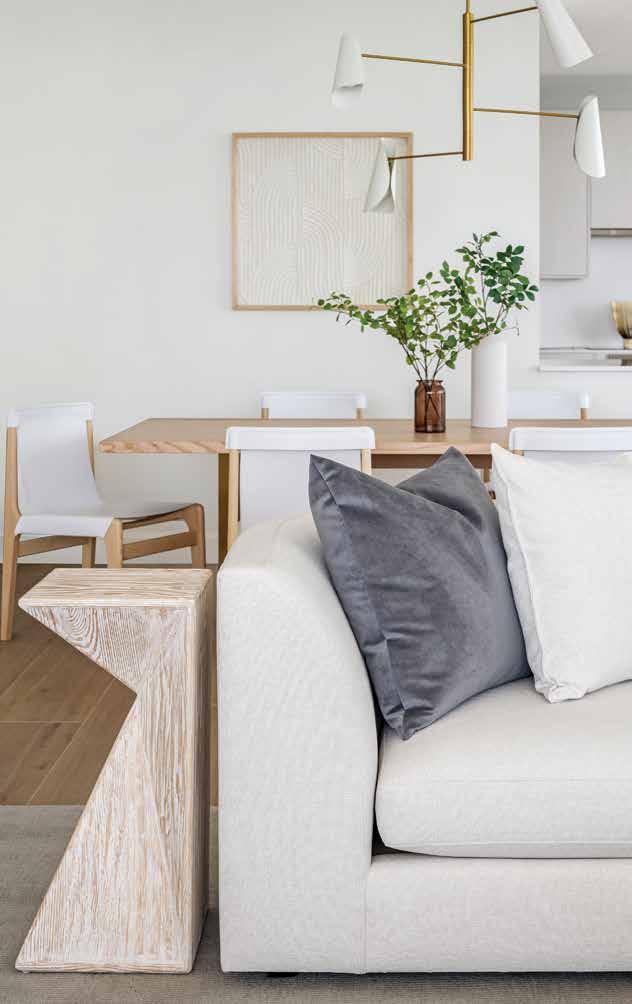
a monochromatic color palette engages the eye through layering of natural textures design by
jaime walters
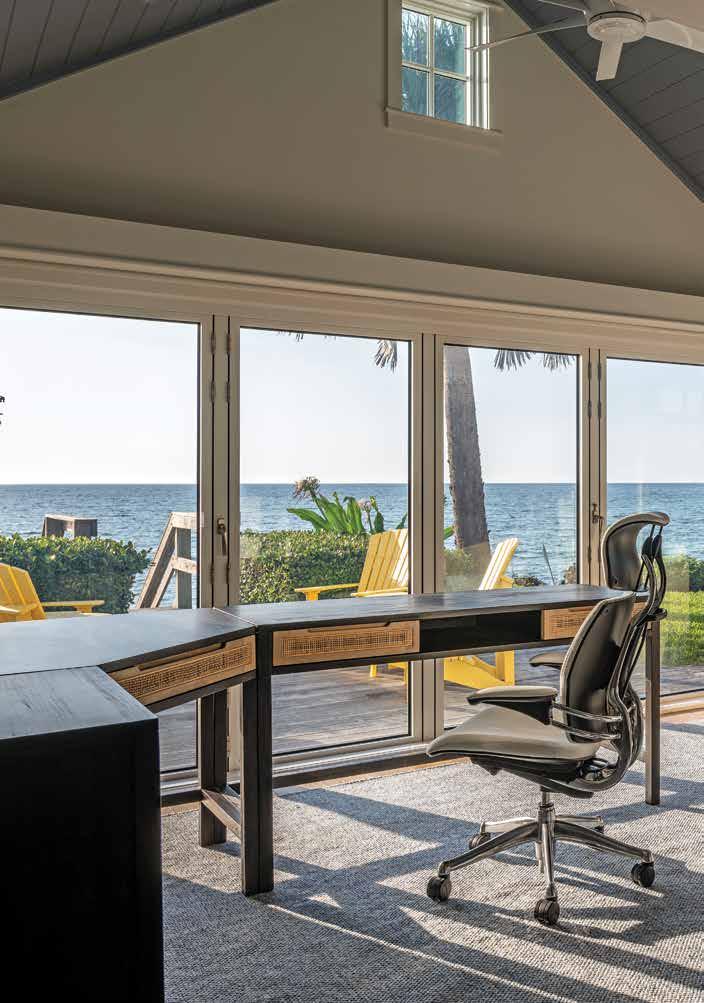
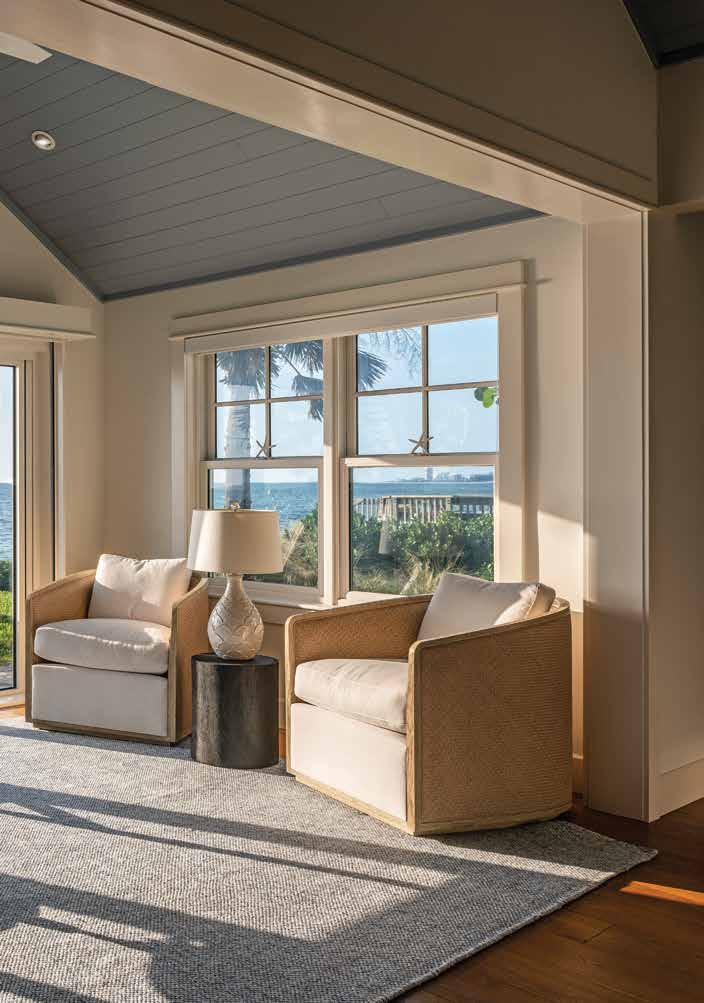
you can add variety and spice to your space by playing with textures, fabrics, and accents. For Walters’ Sarasota project, she balances a rope-woven chair, which fits with the nauticaladjacent beachfront theme of the property, with velvet side chairs. “It’s all about adding a little bit of variation and texture,” says Walters.
Beyond aesthetic concerns, equally key is practicality. Walters’ clients have kids and plan to use this vacation property to host friends and other families. “When you’re talking about beachfront properties or any place, you need to make sure that the fabrics on the pieces that you really care about are protected,” says Walters. In the Sarasota property, she uses outdoor-grade fabric on indoor sofas and goes for stain-resistant wool rugs over the pricier viscose material. “People should be able to walk through the apartment in wet flip-flops and have the moisture not stain the floor,” says Walters. “They just have to think about materials that you can use. You don’t have to worry about your new place getting messed up.”
Walters says being an interior designer is acting as a guide and an expert for their clients. They incorporate their own expertise and knowledge of materials, colors, and design with their client’s personal style. ”I am actually not a beachy person but I love going to this beachfront property in Sarasota and I love the serenity of it,” says Walters. “My client’s taste veers a little bit glam on this
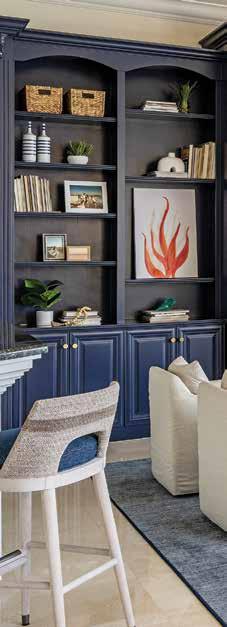
the
of the
design by
deep blues evoke
color
ocean
tracee murphy for trade mark interiors
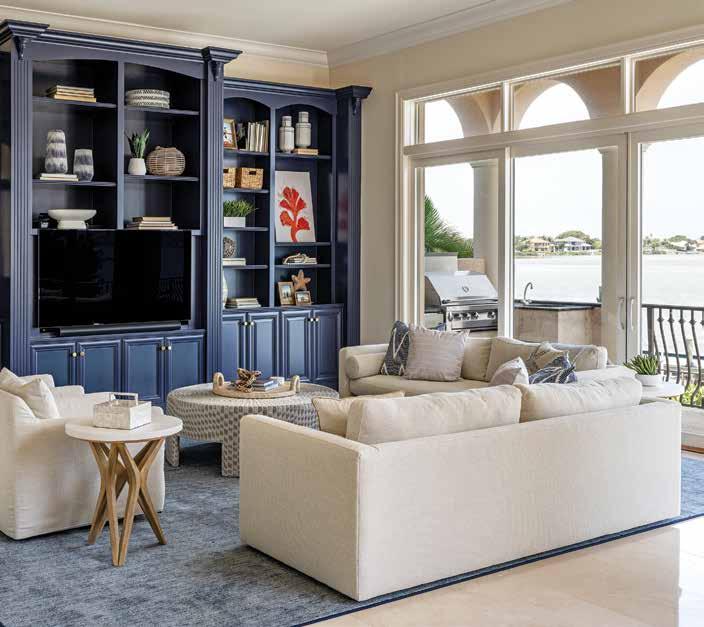
59
project so I knew that my metal accents were going to be brass, which is very complementary.” In order to maximize natural light, Walters says, you need to think holistically about your property and ask probing questions about the space. How do you want it to feel? How do you want it to be used? Who is using this space?
“A great payoff for a client and for me is when they really enjoy their home, and they live in it, and it feels comfortable to them,” says Walters. To her, interior design is a journey and a mutually beneficial relationship between her and her clients. With every project, however, comfort begins with the light. “The lighting is the first thing I notice in anybody’s home,” says Walters. “If a client’s home has excellent, natural light, that’s the first thing I’ll compliment them on.”
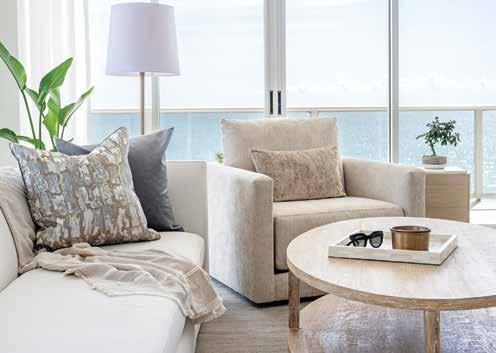
below : room with a view design by jaime walters
Your life’s journey is reflected in the details that surround you. Warm hospitality, personal touches, and legendary Ritz-Carlton service await your return home. Here, meticulously designed Residences capture the beauty of the Pacific Northwest, precisely positioned to elevate your lifestyle. Embrace your moment and live here, always. Opening Fall 2023.









61
LIVE
YOU. EVERYDAY. The Ritz-Carlton Residences, Portland are not owned, developed, or sold by The Ritz-Carlton Hotel Company, LLC, or its a liates (The Ritz-Carlton)®. BPM Real Estate Group uses The Ritz-Carlton marks under a license from The Ritz-Carlton Hotel Company, LLC. Learn more about The Ritz-Carlton Residences, Portland RCRPortland.com RESIDENCES STARTING AT $1.2M
IN THE MOMENTS THAT INSPIRE
Waikīkī’s
Japanese Magic in Portland
Inspiring Architecture
ANstroll through the infamous tourist trap is actually an endless walk through time.
o single person gets the credit for the idea to build a Japanese garden in the southwest hills of Oregon’s largest city. In one account or another, an opaque “community” of supporters banded together about 60 years ago to create the serene space in Portland that is now widely considered the best such garden anywhere in the world—outside of Japan, of course.
It’s fitting that there is no heroine or hero in the rich history of the Portland
The sun is up, but it hasn’t yet reached the cluttered back streets of Waikīkī. Here, everything is bathed in a cool blue light. Seen from a distance, Honolulu’s famous beachfront strip appears as a homogenous blob of blocky beige towers, as if extruded from the sand, the overall

compiled by timothy a . schuler images by john hook a stroll through the infamous tourist trap is actually an endless walk through time

63 hawai ‘ i | exterior
effect one of bland repetition. But like most places, Waikīkī reveals itself slowly, haltingly. A stroll through its streets is a walk through time, though not a linear one. With every step, it seems, you encounter a different era: the 1920s with its grand, ornamental architecture, or the 1950s with its tiki modernism.
Waikīkī is and always has been many things. Its name means “spouting waters” and refers not to the ocean but to the stream-fed wetlands that made the area an agricultural hub even as members of the royal family built residences there. The wetlands disappeared with the construction of the Ala Wai Canal in the
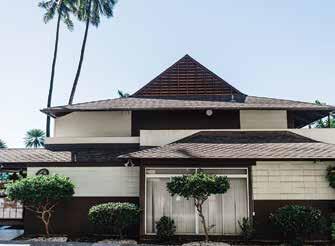
1920s, creating acres of prime beachfront property that soon were populated with hotels and taverns. Since the late 1800s, Waikīkī has also been a place people have called home, slowly evolving into an urban neighborhood with a population of some 20,000 people and a tireless energy.
Not long ago a friend of mine, an architectural historian who lived in
Hawai‘i for several years, sent me a note unbidden. “People often clap back at Waikīkī as an inauthentic place, but I’ve never felt that way,” she wrote. “It’s walkable, and it’s dense, and personally, the combination of tall buildings and mountains gets to me.” Some of her favorite buildings, like the Waikīkī Theater, have been demolished in recent years, she said, “but I’m pleased to see that most of the low-rise apartments still have character. Waikīkī should be a landmark district.”
Unlike some tourist destinations, such as Palm Springs or Miami Beach, Waikīkī isn’t known for its architecture. And yet once upon a time, the area was the playground of the architectural vanguard. In 1957, Buckminster Fuller built one of his famous geodesic domes on the grounds of what is now Hilton Hawaiian Village. The year before, George “Pete” Wimberly, who went on to design the Sheraton Waikiki— which, in 1971, was the largest resort in the world—had given Waikīkī its most iconic structure to date: the hyper-modern, tiki-flavored Waikikian Hotel, whose lobby featured a dramatic, hyperbolic paraboloid roof that curved in two directions and dipped nearly to the ground.
It was as bold as Waikīkī ever got, an outgrowth of post-World War II optimism and Hawai‘i’s increasing prominence in the American imagination. In the 1960s, advancements in commercial air travel shortened the flight time from the West Coast to Hawai‘i from nine hours to less than five, making the islands more accessible than ever. Between 1960 and 1970, visitors increased sixfold and began staying for shorter periods. If this glut resulted in more utilitarian architecture, it also changed what a

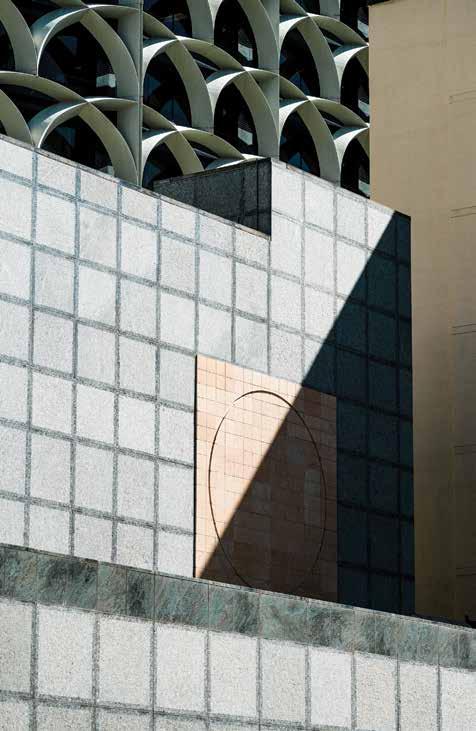

hotel was. Large suites with full kitchens, once de rigeur, were no longer needed. Hotel rooms shrank accordingly and were perched higher and higher in the sky.
Many of Waikīkī’s iconic structures were torn down to make way for ever-larger resorts. The Waikikian closed in 1996, its fantastical lobby and restaurants demolished. Fuller’s dome, which had served as a nightclub and venue for performers like Don Ho, came down three years later. Beachfront property reached such a premium that even tiny parcels were sold off for development. On the sliver of land in front of St. Augustine Church By the Sea, a relic of atomic-age architecture, were built a Burger King and an ABC Store, severing
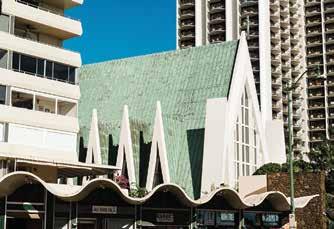
the church from the street and beachfront. Still, a surprising amount of significant works remains. On Kalākaua Avenue, Wimberly’s Waikiki Galleria Tower from 1966, with its arching, tessellated, Escher-like façade, sits next to Hart Wood’s Asian-influenced G. Gump Building built 40 years earlier in 1927, now a store for Louis Vuitton. Some of the seemingly unremarkable walk-up apartment buildings have architectural
pedigrees of their own, like the uber-retro Darlani Apartments, designed by the architects who would later help realize the Hawai‘i State Capitol building.
The neighborhood’s railings alone could fill a coffee table book. They come in every material (wood, steel, iron, concrete) and pattern (leaves, sails, surfboards) imaginable. They bend and wave and zig and zag. They are black, white, aquamarine. Like its ubiquitous breezeblocks or characteristic copper signage, Waikīkī’s banisters and balustrades are functional yet serve as stylistic flourishes. At the Kaiulani Court Apartments on the corner of Ka‘iulani Avenue and Kūhiō Avenue, a breadfruit motif is rendered in black wrought iron. Down the road, on Lau‘ula Street, a twostory building is adorned with subtle wood panels depicting banana leaves in relief. Along with lava rock walls and cantilevered lānai—hallmarks of Hawai‘i’s tropical modernism—the railings are symbolic of the designer’s wish to represent the beauty of the islands in the built environment. They give Waikīkī a sense of self.
Today, the old Waikīkī is seeing something of a revival. Building on a worldwide interest in midcentury modern design, hotels like the Laylow and the Surfjack Hotel and Swim Club have rehabed buildings from the 1950s and 1960s, filling their lobbies with mod-inspired furniture and generating a newfound appreciation for Waikīkī’s midcentury modern architecture.
Last year, the Surfjack partnered with Docomomo, a preservation group devoted to midcentury modern design, to create a selfguided walking tour of some of Waikīkī’s most significant buildings, including the low-rise Beachside Apartments, designed
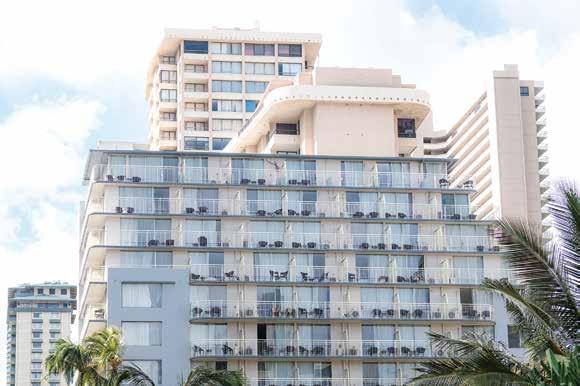
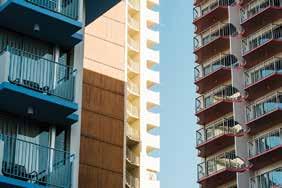
69
in 1959 by pioneering local architect Ernest Hara. Last fall, the Queen Emma Land Co. announced its plans to restore the Beachside Apartments, along with two other midcentury walk-ups on Kānekapolei Street.
Like a song full of samples, Waikīkī defies easy categorization, serving up continually surprising textures and juxtapositions. It is at its best when it embraces this multifaceted aspect of itself, its disparate worlds and clashing styles. The old Waikīkī is not gone. It exists, in pockets alongside every other Waikīkī that has come before and after it, and each future Waikīkī that is yet to come.

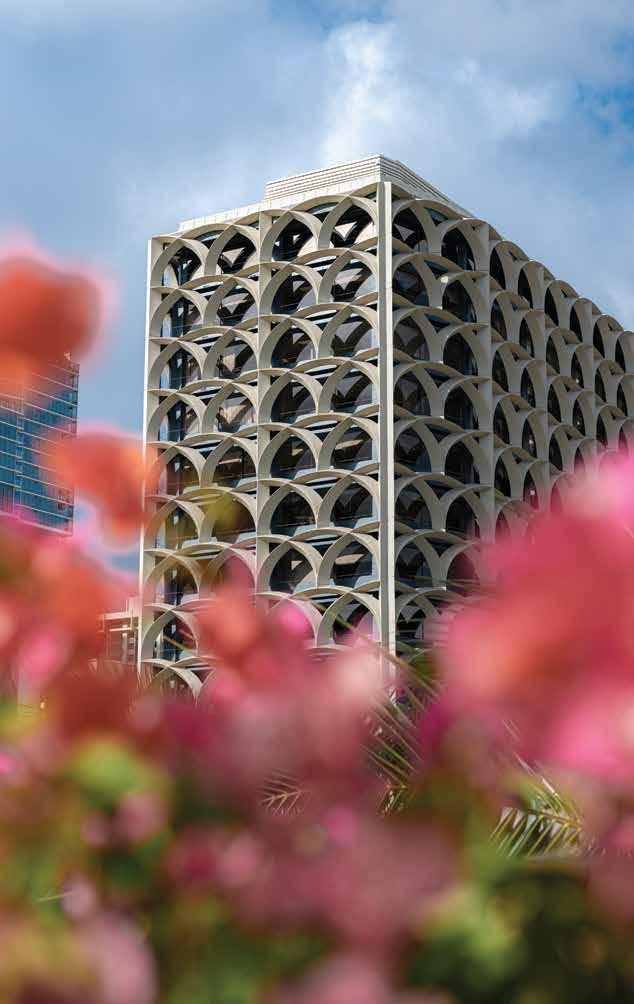
A Serene Sanctuary on Mexico’s Caribbean Coast
Carved from a forest of palm trees, Costa Mujeres is a respite for the overstimulated. It offers generous swaths of the last remaining virgin, white sand beaches in Quintana Roo, the Mexican state long known for its breathtaking seaside beauty. And local development, mostly begun in just the past decade, is now playing out with luxury top of mind.
The dozen-mile stretch sits out past Cancún and the high-rises and rollicking restaurants that have turned that resort
town into one of Mexico’s most popular beach destinations, up a thin strip of land extending into the Caribbean Sea that barely registers on the map. This is a good thing.
As the historic hotel zone in Cancún nears building capacity, new construction in the region has shifted to Costa Mujeres, a half-hour away. New resorts are built in a sort of eco-modern style, blending together with the natural environment. There are none of the shopping centers and markets that crowd other Mexican beach towns.
text by david shortell images by alex azabache , ab living , and joseph barrientos a stone ’ s throw from cancún , costa mujeres offers a unique set of flavors and a very different energy
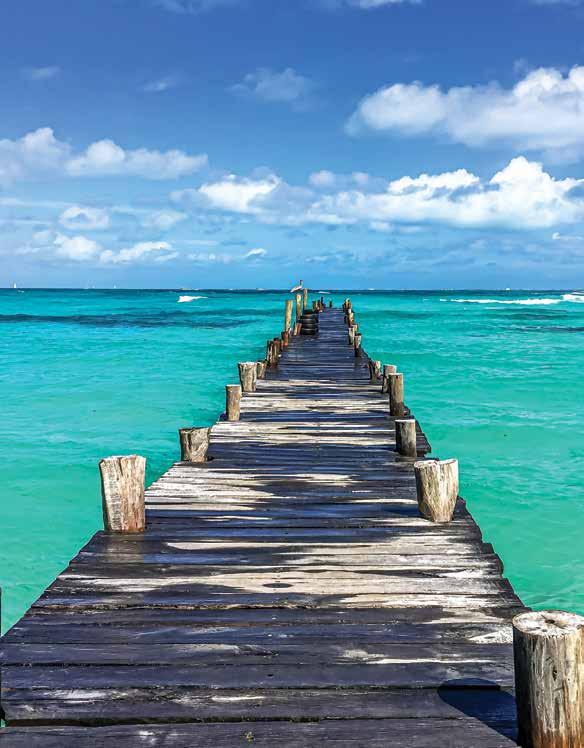
mexico | travel 73
“It will undoubtedly be the new luxury tourism corridor for the Mexican Caribbean,” says Alejandro Bataller, Vice President & CMO of AB Living, a developer behind a number of high-end properties set to open in Costa Mujeres in the coming years, including the first St. Regis in the Cancún area.
“It provides an atmosphere of calm and privacy,” he adds.
With its soft-curving pools and superlative vistas, Costa Mujeres is perfect for the vacationer whose ambitions extend no further than a lounge chair. But choose to venture outside, and filling up an itinerary makes for fun work.
Fernando Torres has been crafting private outings in the area through his Playa Mujeres Trips and Tours since the first hotels rose up. In his catalog: the best spots for snorkeling, fishing, zip-lining, and ruinhopping. But the array of local wildlife might steal the show. “There are iguanas of every size. You’re going to see them everywhere,” Torres said. “You’ll see flamingos, you’ll see many herons. Then we’ll get on the water and out past the hotels, you can see dolphins, and a bit further away, toucans.”
Cancún is, of course, right there—a sober drive to the cantinas and nightclubs slinging cold Corona and tequila being the only ticket needed for revelry.

a bedroom inside ab living ’ s the st regis costa mujeres residences

75
But think bigger, and at Isla Blanca, the narrowest point of the region, only a few hundred meters of sand separate two staggering coastlines. To the east, the Caribbean; to the west, a vast lagoon that’s dotted with the floating Day-Glo parachutes of a school of kitesurfers.
“It’s the best place to learn,” said Gianpaolo Cangiano, the owner and an instructor at Kitesurf Mexico.
Strong north winds propel the surfer, tethered with a harness to his kite, like a sail. Calm, hip-high waters are generous to wobbly beginners. Cangiano says he’s taught ages seven to 70. “Often, we’ll start teaching a family member, and then the wife and the children will want to join. There are entire families that kitesurf,” he said.
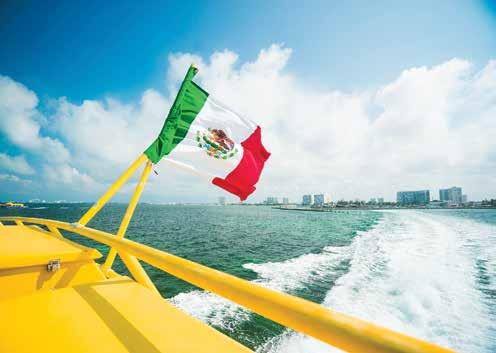
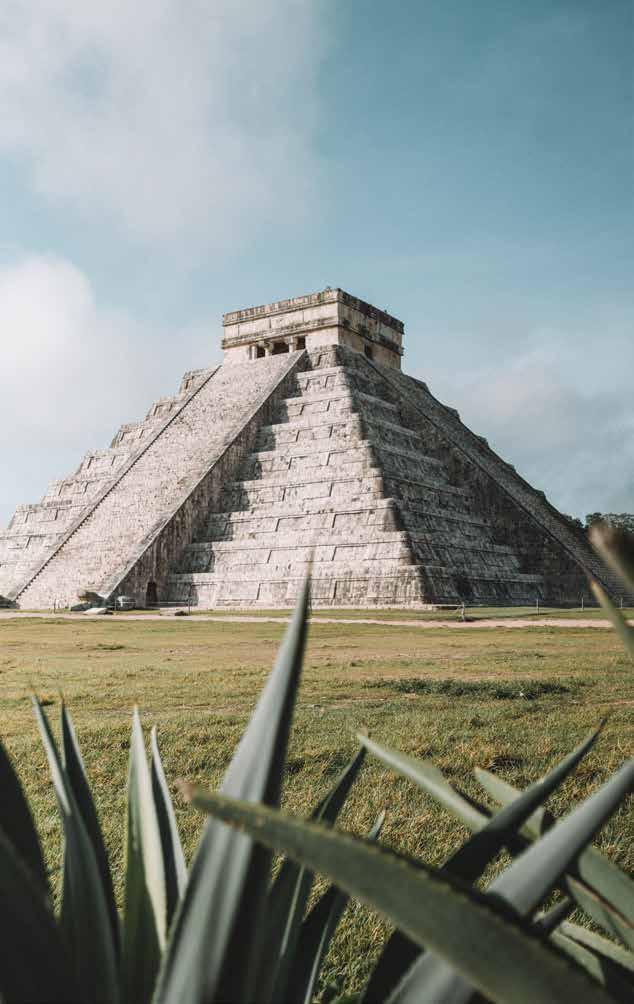
For a more traditional, land-based sport, two marquee names stick out: Greg Norman and Rafael Nadal. Both iconic athletes have exclusive outposts in the area.
Norman, the golf tycoon and former world No. 1, is known for building courses that match their surroundings. In Costa Mujeres, that means 18-holes lined by palm trees and Caribbean views pushing sea breezes that demand precise swinging.
At the Rafa Nadal Tennis Centre, the Spanish king of clay’s only training facility in North America, group and private lessons for all levels are taught by coaches versed in the same method
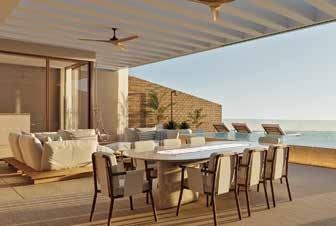
that Nadal has relied on to earn 22 Grand Slams, prioritizing mobility, intensity, and forward-thinking.
Down the beach from the state-of-the-art facilities, which include eight clay courts and a museum housing some of Nadal’s trophies and gear, lives a markedly less modern site: the El Meco ruins, a Mayan trading center dating back to between 300 and 600 A.D.
Archaeologists believe the settlement played an important part in the maritime traffic of the ancient inhabitants in the area, down to the influential city of Coba. At its center, a steeply tiered pyramid looms 12.5 meters high.
The marriage of the ancient and modern is a theme here. And at María Dolores, the Costa Mujeres outpost of celebrity chef Edgar Núñez, elements of Mayan cuisine play a starring role.
Núñez is among the most important purveyors of his country’s cuisine in the world: his Mexico City homebase, Sud 777, is one of just four Mexican restaurants on the list of the World’s Best 100. At María Dolores, dramatic stone pillars and rich leather seating provide a transformative fine-dining experience.
The recados are a favorite. A kind of Mayan mole, the sauces are prepared to dress an octopus and suckling pig dish by a designated member of the kitchen staff.
“Before, in the towns, there used to only be one mill,” Núñez says in an interview, “and people would bring what they planted to the recaudería”—a collecting site or store—“and the miller would grind them to a paste. That’s where the name recado comes from: from collecting things.”
“I try to get a little inspiration from all the cultures of my country,” Núñez says.
Perhaps that’s the majesty of Costa Mujeres, a seamless combination of all that this country has to offer: inspiring history, unparalleled nature, and some of the best food you’ll ever eat. And it’s all just beginning here in Mexico’s newest paradise.

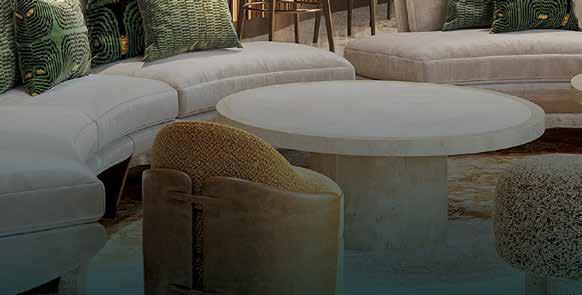


Welcome to a rare life within nature, nurtured by legendary service. With a private lagoon and aquatic preserve in your backyard. The Saltleaf marina and golf course in your neighborhood. And hospitality that frees you to enjoy it all. Residences now selling from the $3Ms. Choose your views now. Occupancy in early 2026. SW Florida | TheResidencesEsteroBay.com | 239.920.7622 WONDER OUTSIDE, WONDER INSIDE The Ritz-Carlton Residences, Estero Bay are not owned, sold or developed by The Ritz-Carlton Hotel Company, L.L.C. or its affiliates (“The Ritz-Carlton”). LB Estero Bay Investments, LLC uses The Ritz-Carlton marks under a license from The Ritz-Carlton, which has not confirmed the accuracy of any of the statements or representations made herein. NOW UNDER CONSTRUCTION
eat & drink
A nourishing pastime
atlanta / global
image by diwang valdez
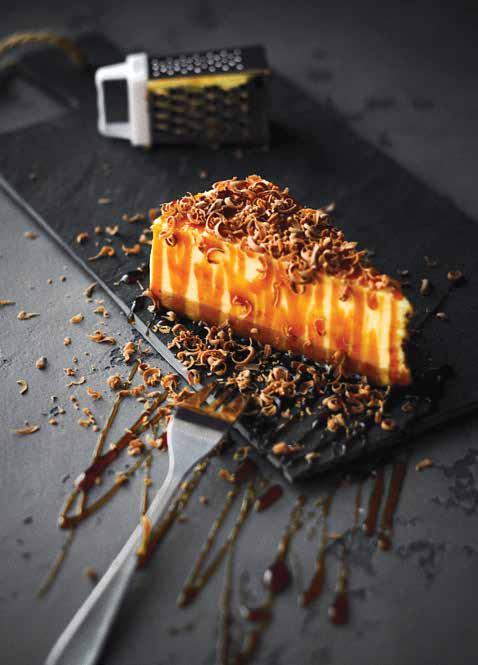
81
Atlanta’s Top Chefs
The Atlas restaurant is quintessential fine dining with a playful, modern twist. The restaurant’s walls are lined with works by Japanese-French artist Léonard Tsuguharu Foujita: a serene garden, whimsical ballerinas, and his famous feline portraits. This is juxtaposed with a classic British rock soundtrack—The Rolling Stones, Duran Duran—that Head Chef Freddy Money remembers listening to growing up in England. “We are informal luxury,“ he says.
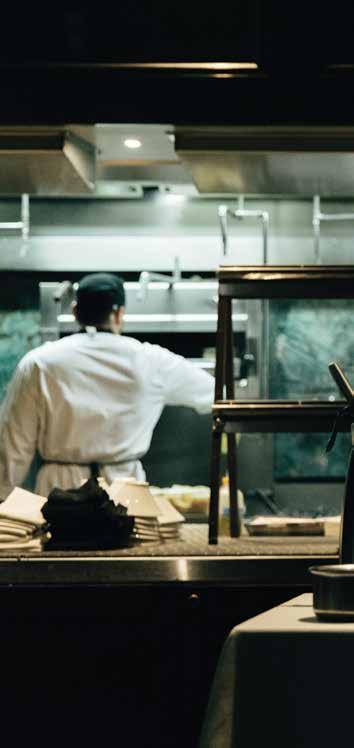 text by sowmya krishnamurthy
text by sowmya krishnamurthy
after a summer of improvising , two stars of the scene in a southern food stronghold are ready to take the next step back at home
images by diwang valdez
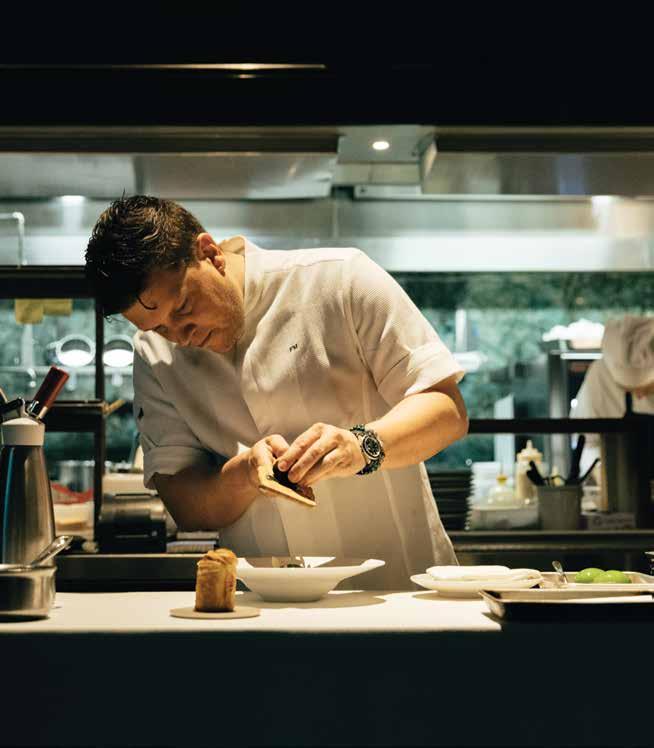
atlanta | dining 83
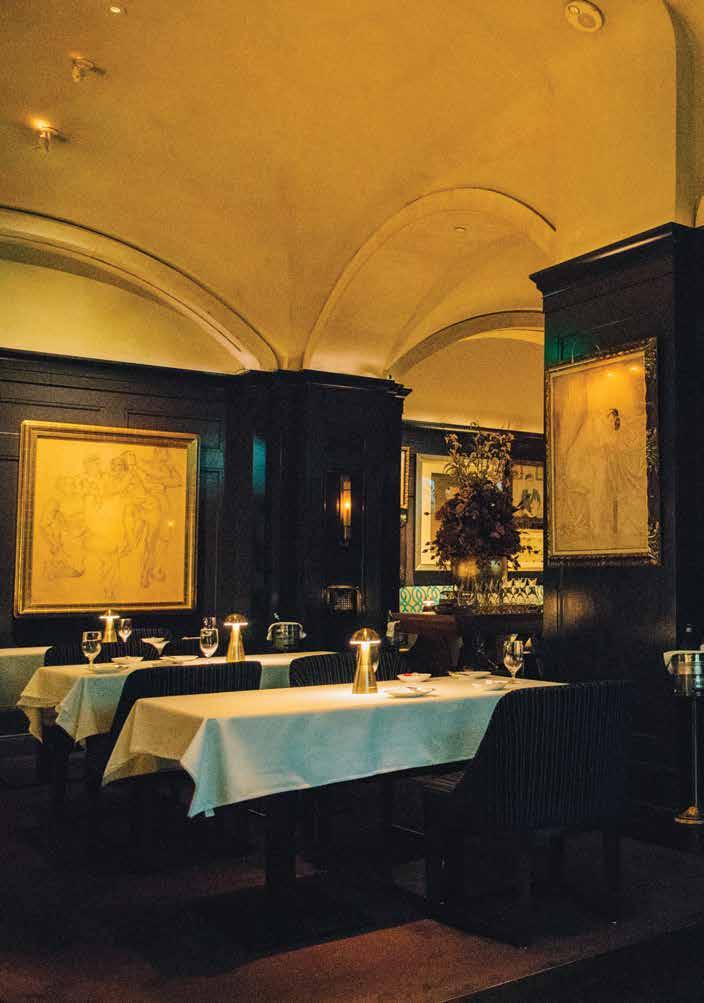


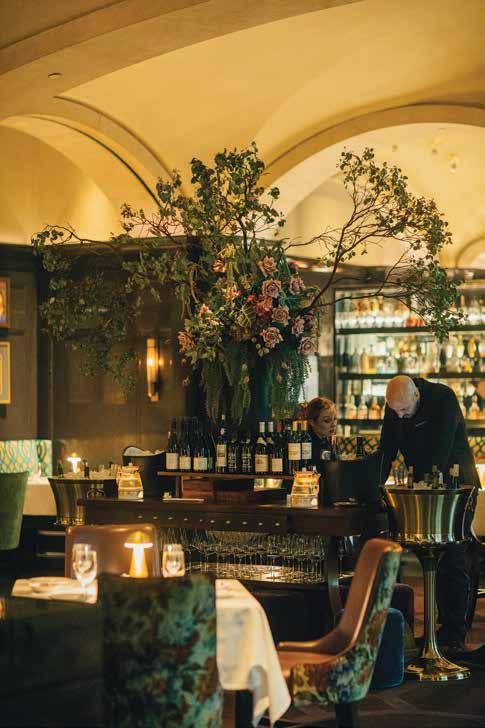
It’s this juxtaposition of the refined and the casual inside The St. Regis Atlanta that has helped Atlas make a name for itself as an “unparalleled culinary experience” with thoughtfully plated American cuisine. The restaurant has won several awards, including four stars from Forbes Travel Guide.
But this past summer, the restaurant was closed temporarily for kitchen renovations. Rather than sit on the sidelines, Money and his colleagues sprang into action, launching a series of temporary pop-ups including a dessert boutique. In July, Atlas collaborated with Chef Michael Elégbèdé of ÌTÀN test kitchen in Ikoyi, Lagos, for a limited eight-course tasting menu that featured ingredients, flavors, and techniques of his West African culture. Now, Atlas opens its doors once again and offer diners the food that has come to define it.
Chef Money takes a holistic approach to curating his menu. “I get inspiration from
past experiences. I get inspiration from my surroundings,” he says. “What’s best in season and what’s freshest? Then, we manipulate those ingredients using all the techniques that we know to create the dishes. Inspiration at a high level is driven by seasonality and ingredients at our fingertips.”
The tasting menus take center stage and are also offered in vegan and vegetarian iterations. The chef’s favorites include Kristal Caviar (with Otoro tuna and Ponzu Crème) and Westholme wagyu. “We always start the meal with a little sense of luxury, so we always start with caviar,” explains Money, who trained in Europe and worked behind the pass for the Alain Ducasse Group. Next comes an assortment of shareable snacks inspired by the chef’s roots, like the jammie dodger— a British biscuit—made with chicken liver and cherries. The menu also features a halibut dish, a personal favorite of the chef that is lightly cured and cooked at
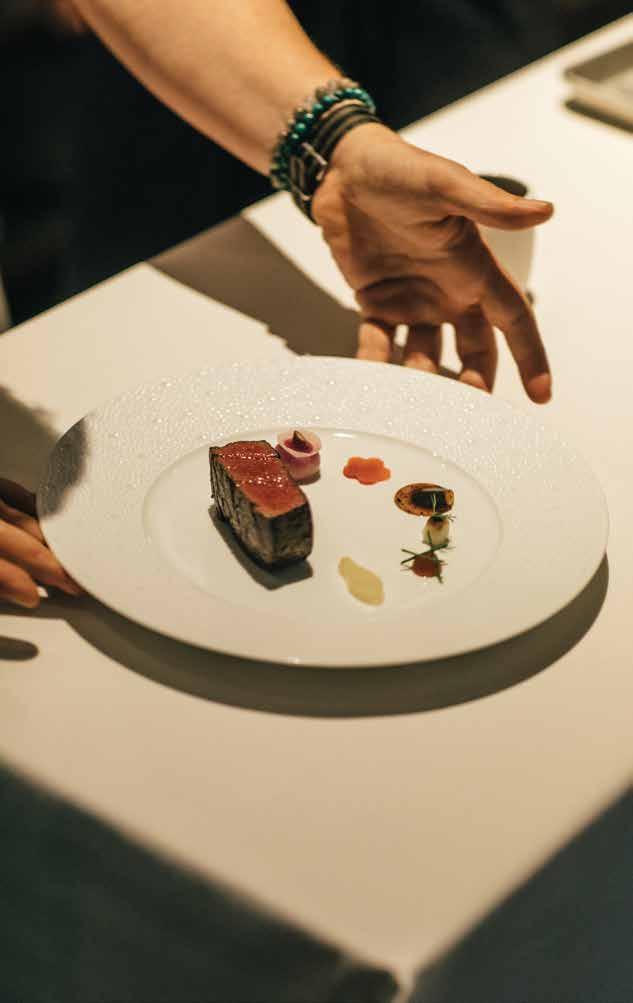

a very low temperature. “And what this does, it creates the most beautiful, moist, tender piece of fish,” he explains. This is paired with citrus and a beet reduction.
Money also recommends his signature Rocher with hazelnut and chocolate. “You tap it with the back of your spoon and it’ll burst this delicious, chocolate cream all over the plate,” he crows. Executive Pastry Chef Eric Snow, biased though he may be, agrees that the experience is not to be missed. “We let the diner clap and it kind of explodes all over the plate and the table and it’s just a fun little experience,” he echoes. “And it’s a little bit different than I think what you’d see down the street.”
Snow also points to the Baba au Rhum, which comes with chantilly à la vanille,
and the la vie en rose—which combines vanilla parfait, meringue, raspberry Sorbet and liquid Nitrogen Rose—as crowd pleasers. Snow obtained his first Pastry Chef position at Joël in Atlanta and honed his skills across fine dining establishments including Alain Ducasse at the Essex House, Mix, and Daniel Boulud’s Café Boulud Palm Beach.
He draws culinary inspiration from the desserts he grew up with in Atlanta. “I love taking childhood memories and desserts that you’d see at birthday parties or what your mom would cook for you and putting a French twist on it,” he says. “Red velvet cake was something that I really enjoyed. That was always the birthday cake.”
For his series of chouxs, a delicate French pastry similar to an eclair, he draws on this nostalgia. “I have a red velvet eclair, just kind of fun little play on that.”


The Card for Extraordinary Journeys Elevate Your Travels With the Marriott Bonvoy Brilliant® American Express® Card Learn more at www.americanexpress.com/us/marriottbonvoycreditcards/

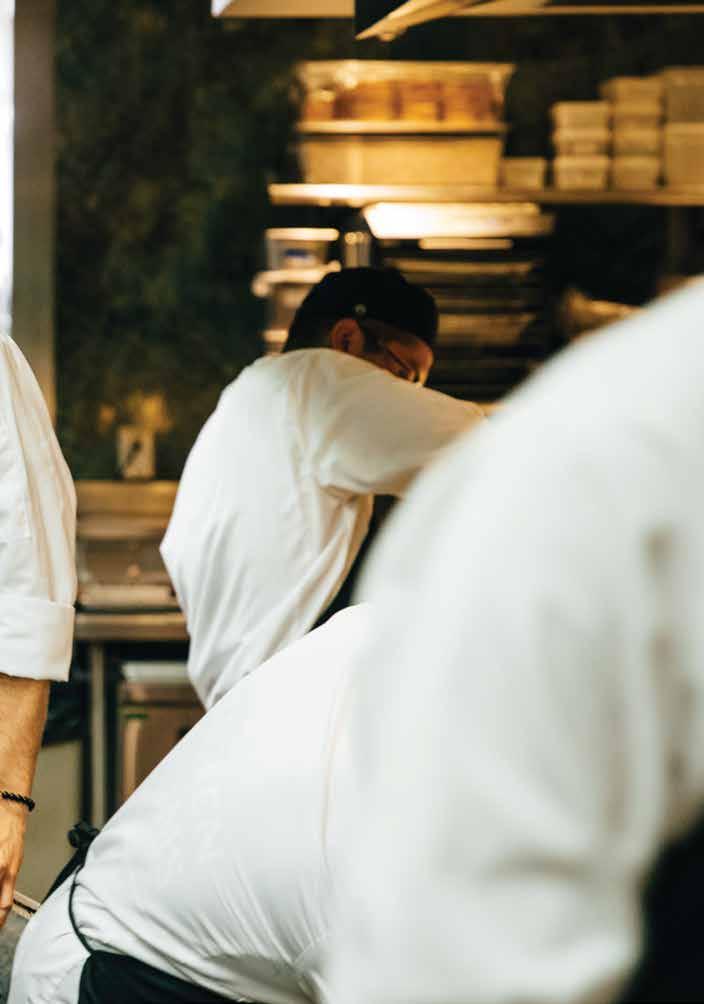
Although the food is meticulously prepared, the chefs strive to ensure that the Atlas is always warm and welcoming—an effort that is sometimes absent in fine dining.
“It’s our responsibility to make sure that everybody’s going to receive the same love and attention as family or a friend,” says Snow. That means always having a little bit of play and whimsy. “We respect the process, but I don’t want the guests to feel overwhelmed, like they have to sit there in a bow tie and act a certain way,” Money says. “I want to welcome them with open arms and a fist bump over a handshake and a hug over an awkward hello.”

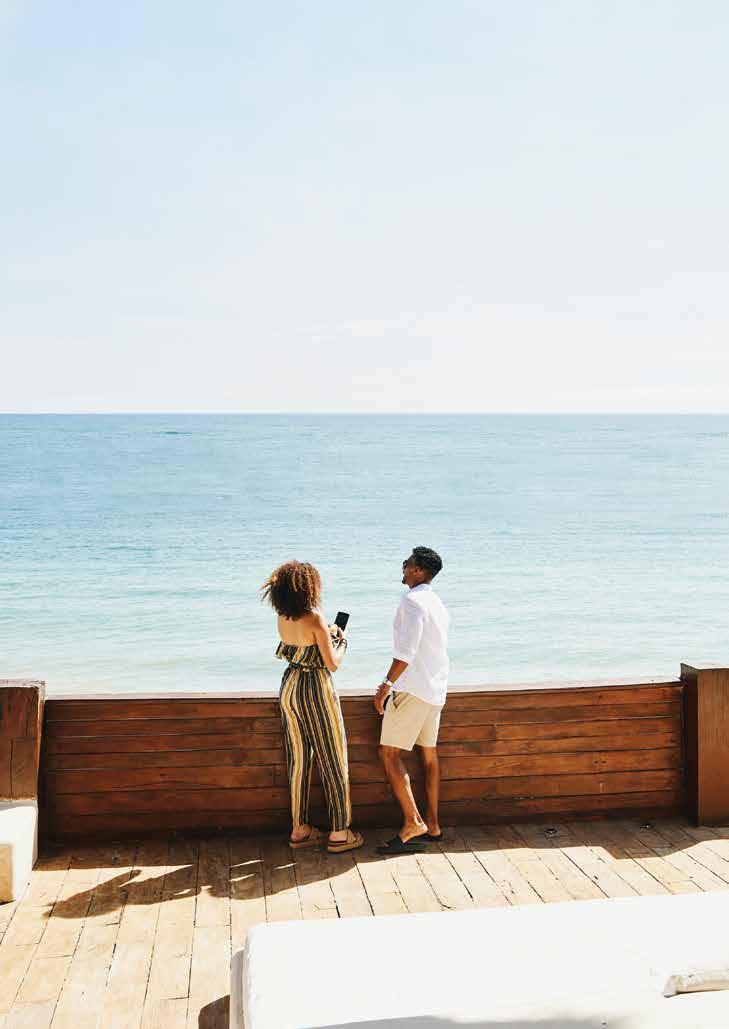

The Card for Your Next Destination Earn Faster to Get Away Sooner With the Marriott Bonvoy Bevy™ American Express® Card Learn more at www.americanexpress.com/us/marriottbonvoycreditcards/
Holiday Eats
Every region of the country has its own unique take on the holiday food, incorporating its own culinary traditions, local produce and ingredients, and of course, the tastes of people who have settled there throughout the years.
No matter where in the U.S. your holiday travels take you, this coast-tocoast food guide will prep you for what might grace your plate—and the best local spots to sample these dishes.
butternut squash
Where: New England
The first Thanksgiving was in New England, so it’s no surprise this region remains close to the original menu eaten by the Puritans and Native Americans. New England butternut squash is a close relative of stewed or boiled pumpkin, which was believed to have been enjoyed in the 1600s. The updated version is often seen pureed or made into a casserole with maple syrup and cinnamon for a sweet side dish.
Take in Boston Harbor views and Thanksgiving dinner with all the trimmings, including butternut squash, at 75 on Liberty Wharf in Boston, Massachusetts.
sauerkraut
Where: Baltimore
Sauerkraut isn’t just for hot dogs or Reuben sandwiches. German immigrants in the 1800s brought the tangy dish to Baltimore at just around the time that Thanksgiving was declared a national holiday in 1864. It’s been a staple ever since. Fans love the tartness of the fermented cabbage to offset rich turkey and sweeter fare like cranberries and sweet potatoes.
Head to Das Bier Haus for traditional German brews and beerhall fare, including seven different types of sausage served with sauerkraut.
frog - eye salad
Where: Western United States
Despite its name, frog-eye salad doesn’t (thankfully) include amphibians or eyeballs. Frog-eye salad (also called Frogeye or frog’s eye salad) is a pasta-based dessert popular in the Western part of the country, in states like Utah, Nevada and Wyoming.
The dessert resembles rice pudding and features acini de pepe, a bulbous pasta similar to orzo. Mix-ins vary but can
by sowmya krishnamurthy what do different regions of the u s eat for thanksgiving , christmas , and beyond

global | food 97
include vanilla pudding and sweetened coconut flakes along with fruit like mandarin oranges and mini marshmallows.
Many attribute the salad’s popularity to Mormon cuisine. Mormon culture is based in Utah and has spread to Nevada, Wyoming and California (known as the “Mormon Corridor”). Recipes often include convenience foods like Jell-O or pudding mix. With an emphasis on communal and social gatherings like potlucks and buffets, dessert salads are especially popular.
Enjoy casual, buffet-style eating and sample frog-eye salad at one of the Mormon Corridor’s oldest buffet restaurant chains, Chuck-A-Rama.
spinach maria
Where: Tennessee
In Tennessee, Spinach Maria is a popular skillet dish that’s a spicy twist on creamed spinach. The cheesy dish features Monterey Jack, cheddar, and Velveeta and a kick of heat from red pepper flakes—all baked until bubbly hot.
The dish’s origins go back to Calhoun’s, a local steak and barbecue restaurant in East Tennessee, that opened in 1983. During holidays Tennesseans swap traditional spinach casserole or creamed spinach for their own copycat restaurant version of Spinach Maria.
Go back to where Spinach Maria originated by stopping at Calhouns. Don’t forget an order of ribs!

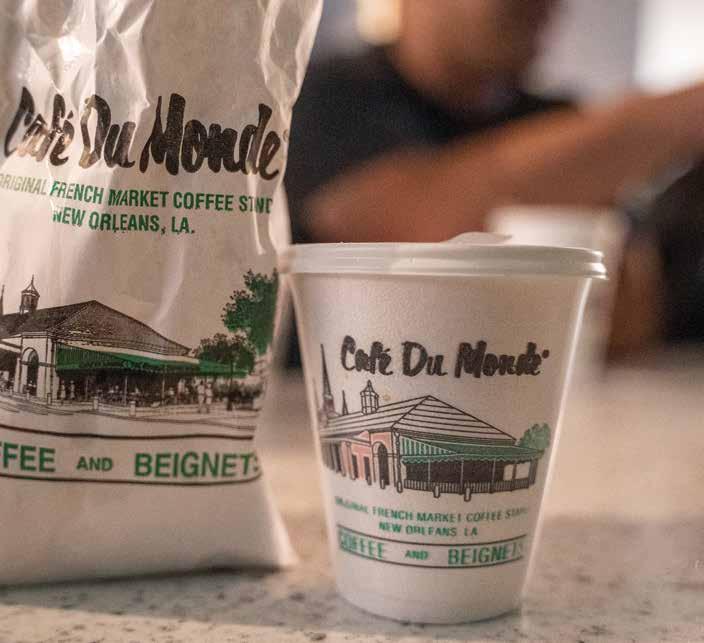
99
flan de calabaza
Where: Florida
In South Florida the influences of Cuban and Caribbean culture are undeniable. Flan de calabaza takes a popular Latin dessert, flan, and combines it with calabaza (pumpkin) for the holidays. Made with condensed milk, cinnamon and pumpkin, it’s a seasonal twist on a familiar favorite.
Cuatro Leches Dessert Bakery has been serving Latin-American desserts in Miami for more than 30 years. Pick up the flan de calabaza plus the famous tres leches.
cheesy potatoes
Where: Michigan
From mashed to au gratin, potatoes are a Thanksgiving staple. When in Michigan, try a state favorite: cheesy potatoes. As its name suggests this indulgent side dish features hash-brown potatoes oozing with cheese, sour cream and cream of chicken soup. Don’t forget the crushed potato chips on top.
Michigan had significant waves of German immigration and this side dish is likely a modern twist on Kartoffelgratin, a German potato casserole.
Head to Rykse’s award-winning, familyowned restaurant in Kalamazoo, Michigan— serving food from scratch for more than 31 years—for their cheesy potatoes.
sopapilla cheesecake
Where: Texas
The holiday cuisine of Texas is greatly influenced by its Mexican heritage. Sopapilla cheesecake combines sopapilla,
a sweetened fried dough believed to have originated in Spanish culture hundreds of years ago, along with American cheesecake ingredients to create a buttery, sweet and cinnamon-infused dessert.
Sopapillas are enjoyed in many Spanishspeaking countries. For Mexican Americans celebrating the holidays in the Lone Star State, sopapilla cheesecake is truly a cultural fusion.
Get a taste of sopapilla cheesecake at Bake Diva’s Bakery—which offers homey recipes inspired by the owner’s mother—in Burleson, Texas.
mirliton casserole
Where: Louisiana
With French, Spanish and African influences, the food of Louisiana reflects its international roots. Mirliton is a pale green squash (known as chayote in other parts of the country) that is dubbed the unofficial squash of New Orleans.
Mixed with Louisiana staples like Creole spices and shrimp—and sometimes spicy andouille sausage—this casserole (also called a dressing) is a favorite side dish in Louisiana.
In New Orleans, Louisiana, some of the most beloved mirliton dressing comes from the local supermarket. Head to a Breaux Mart location for this holiday favorite.

forward
A catalyst for departure
qatar
image by visit qatar

103
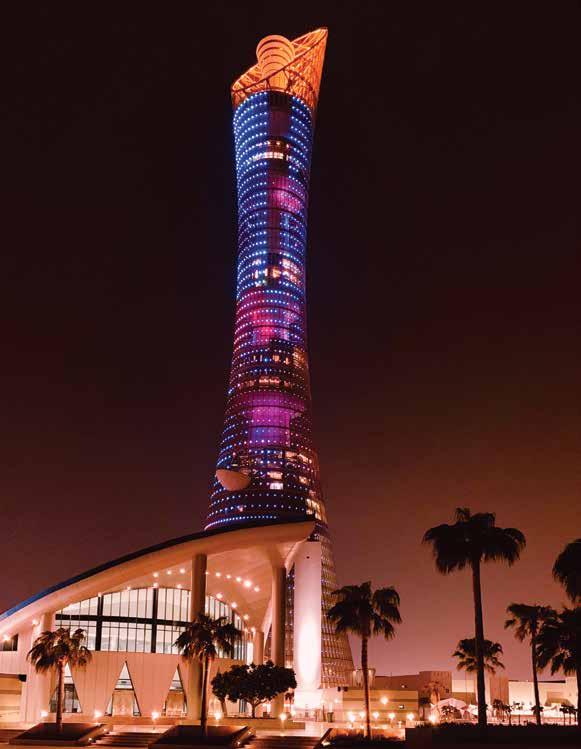
104 qatar | travel
Doha’s Next Act


Doha is a city of contrasts, and descending upon it by plane is a striking experience. Arrive by day and you’ll see a gleaming, contemporary hub rising up from the horizon, where an unending expanse of scorched sands meets the turquoise Persian Gulf. Arrive by night and you’ll see a glittering metropolis appear
sustainability and art take center stage in the middle east ’ s most exciting city
text by todd plummer images by visit qatar
left , the aspire tower in doha , qatar right , the lamp bear sculpture by swiss artist urs fischer is displayed in doha airport
from the darkness as if out of nowhere. Either way, there’s an inescapable sense that this city is both a major highway of the world and a destination in its own right.
Step off the plane into Hamad International Airport and the fever dream continues. People from every walk of life and all around the globe criss-cross the terminals in a dazzling array of cultures and spoken languages. Yet despite the airport’s global footprint, a sense of serenity and efficiency permeates the air. People aren’t rushed here— they’re enjoying all that this place has to offer.
Families gather around art installations for photos. Fashion lovers shop the array of luxury boutiques, which are second to none. Health enthusiasts make the most of long layovers with a spa treatment or workout at the in-terminal Wellbeing & Fitness Center. The atmosphere is glamorous and energetic— proving that age-old adage about the journey being as important as the destination.
Flying through Doha’s airport is by any measure a rewarding experience. But taking the time to experience this city itself is the real treasure.
For centuries, Doha was little more than a sleepy fishing and pearling village. It wasn’t until the discovery of Qatar’s oil reserves in the mid-20th century that Doha’s wealth began to come into focus; once Qatar declared independence from Britain in 1971, the country’s future trajectory achieved liftoff.
The Doha of today features many of the things that make Middle Eastern cities attractive and internationally resonant for visitors, from luxury hotels and European boutiques to fine dining. But what sets this city apart is its commitment
to fostering a cultural renaissance and investing in the arts—a series of goals and values espoused in Qatar National Vision 2030, a strategic blueprint for the city’s sustainable development.
The city seems determined to at least consider its relationship with the planet. Sustainability takes center stage at the Expo 2023 (formally, the “2023 International Horticultural Exposition”), which runs from October 2023 through March 2024. The Expo will explore the theme “Green Desert, Better Environment” as a platform for sharing initiatives and best practices for a more sustainable future. Fifty-one countries will participate, bringing Doha’s message of innovation around the world.
The other definitive pillar of this city’s future is its commitment to art. Hamad International Airport acts as a literal link to the rest of the world, but investments in art and design position Doha as a figurative link between contemporary cultures everywhere.
The city’s public art and museum offerings are immense. The Museum of Islamic Art is one of I.M. Pei’s architectural masterpieces, and houses one of the world’s most comprehensive collections of Islamic art. Pritzker Prize-winning architect Jean Nouvel’s stunning National Museum of Qatar consists of interlocking discs of varying diameters and curvatures, reminiscent of a desert rose. And site-specific, largescale art works from Jeff Koons and Olafur Eliasson demonstrate that Doha’s desert landscape lends itself to aesthetic creativity.
“Doha offers a rich tapestry of cultural influences, making it a dynamic and inspiring place for artists and architects,” says Khalifa Al Obaidli, director of Fire Station, the official
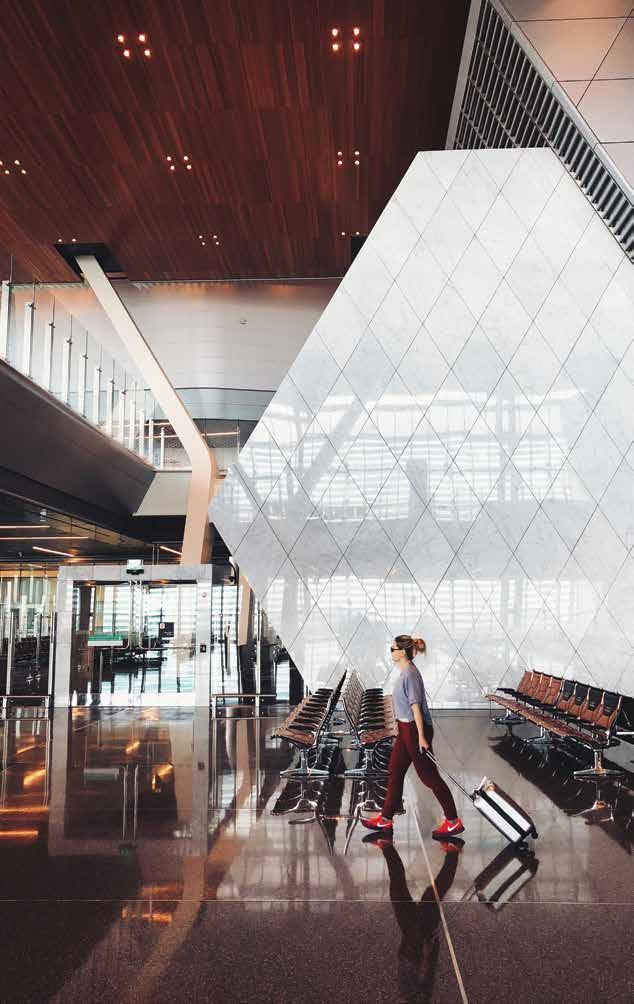
Qatar Museums’ artist-in-residence program. This city’s cache of luxury shopping and five-star hotels has less to do with luxury for luxury’s sake, then, and more with attracting the world’s best audience for creative talent.
“For artists, Doha’s museums and galleries, along with the patronage of Qatar Museums, offer exposure to diverse audiences and a chance to engage with a rapidly growing art scene,” Al Obaidli says. “The support for artists and architects in terms of grants, residents, and collaborations is noteworthy. As Doha continues to position itself as a global cultural hub, the value of building, exhibiting, or performing here lies in being part of a transformative journey that transcends boundaries.”
If you don’t have enough time to visit all of the city’s museums on your trip, don’t worry—there’s plenty of art and design in the airport that you can appreciate before your flight home. A soaring “orchard” atrium with suspended walkways offers a soothing and natural atmosphere, and the terminals are lined with works from world-renowned artists like Ahmed Al Bahrani, Jean-Michel Othoniel, KAWS and more.
Perhaps the most iconic work of all is Urs Fischer’s 23-foot canary yellow teddy bear sculpted in bronze. It’s a perfect emblem of what this city has to offer—both a landmark from which to orient yourself in a dizzying cultural crossroads, and a symbol of Qatar’s growing relevance in international culture.
 the museum of islamic art in doha , qatar
the museum of islamic art in doha , qatar
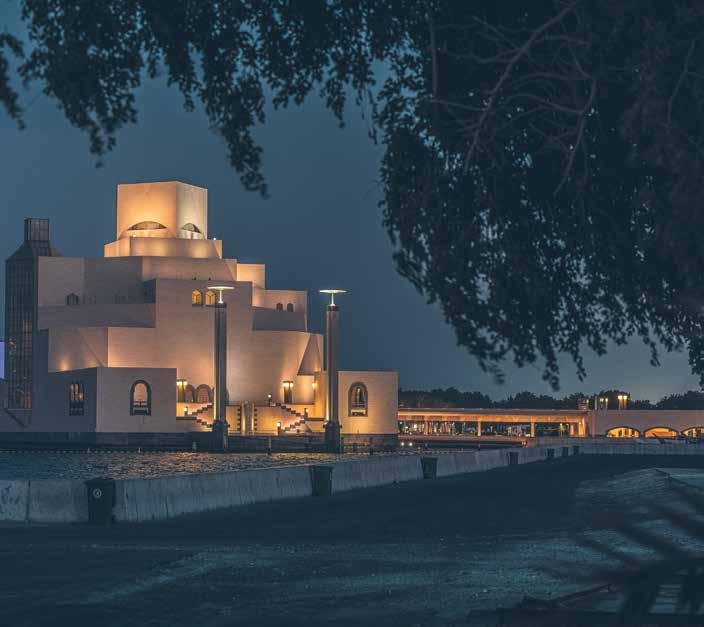
109
hello
Welcome Home
A welcoming gesture
Explore Marriott International’s collection of branded residences
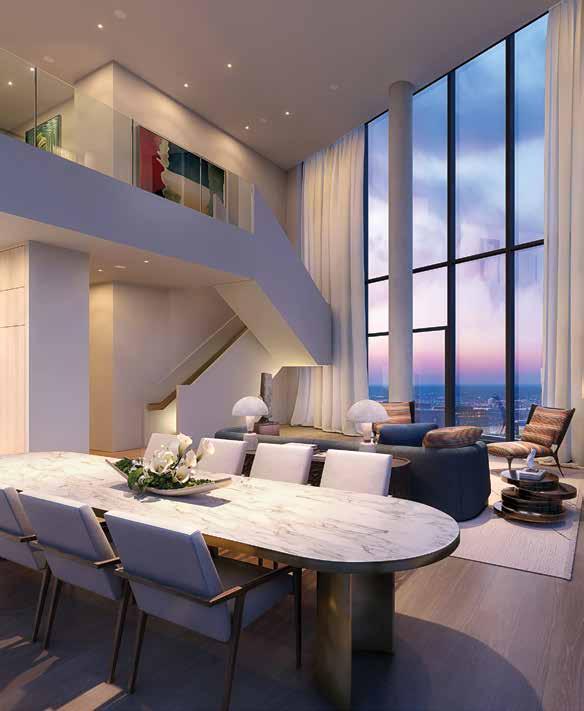
111
the ritz - carlton residences , boston , south station tower
Les Nouveaux
Exceptional developments that set a new standard in extraordinary hotelinspired living is taking shape in highly desired urban neighborhoods and lush natural sanctuaries in Boston, Cairo, and Ho Chi Minh City.
Siari, a Ritz-Carlton Reserve Residence will feature 39 luxury four- and five-bedroom homes when it opens in 2025, set within an 800-acre cliffside enclave called Nauka along Mexico’s Pacific Coast. Inspired by Nayarit’s dense rainforests, cenotes, beaches and ocean, each residence will embrace indooroutdoor living with glass doors that open onto terraces covered with lush greenery. Amenities include a deep-slip Marina and Yacht Club, an 18-hole Tom Fazio-designed golf course; meditation glass house; volcanic preserve; whale cove; stargazing observatory; and miles of jungle hiking, biking, and running trails. Owners will also enjoy a private beachfront with clubs and restaurants, and access to the hotel with three restaurants, bars, a modern beach club, pools, spa and fitness center, pickleball and tennis courts, and a library cocktail lounge.
As one of Boston’s tallest buildings set to reshape the Boston skyline, the 51-story South Station Tower will house The Ritz-Carlton Residences, Boston, South Station Tower on the building’s top 16 floors when it opens in 2025. Owners of the 166 homes with floor-to-ceiling glass windows will have panoramic views of the city and Boston Harbor near the edge of Seaport, and access to the largest transportation hub in
New England. Providing a natural retreat in an urban setting, the tower includes an expansive private park with meeting spaces, a dining terrace, gardens, walking paths, activity lawns, and pool deck facing the western sunset.
With a prime location along Saigon River in the heart of Ho Chi Minh City’s District 1, Grand Marina Saigon, a new mixed-use riverfront development, will host JW Marriott Residences Grand Marina, Saigon and Marriott Residences Grand Marina, Saigon , a new marina and promenade that follows the historic river and past an oasis of green parks and plazas. Masterise Homes, a local real estate developer of The Ritz-Carlton Residences, Hanoi , is behind the skyline-defining residential towers, which have direct views of the Bitexco Financial Tower, Saigon Zoo and Botanical Garden, and iconic Landmark 81.
W Residences Cairo , the first W-branded residential property to open in Africa, will feature 300 residences when it opens in 2026. Located at One Ninety in New Cairo, one of the most prestigious addresses in the city, the development will offer a mix of penthouses, garden villas, and furnished two- to four-bedroom residences that provide access to the W brand’s signature irreverent attitude and taste for design-led luxury, as well as Whatever/Whenever service, WET pool deck, FIT gym, AWAY spa and fine dining options. The unique leveling design of the building provides not only privacy but also spacious terraces with stunning views.
new branded residences
riviera nayarit / boston / ho chi minh city / hanoi / new cairo
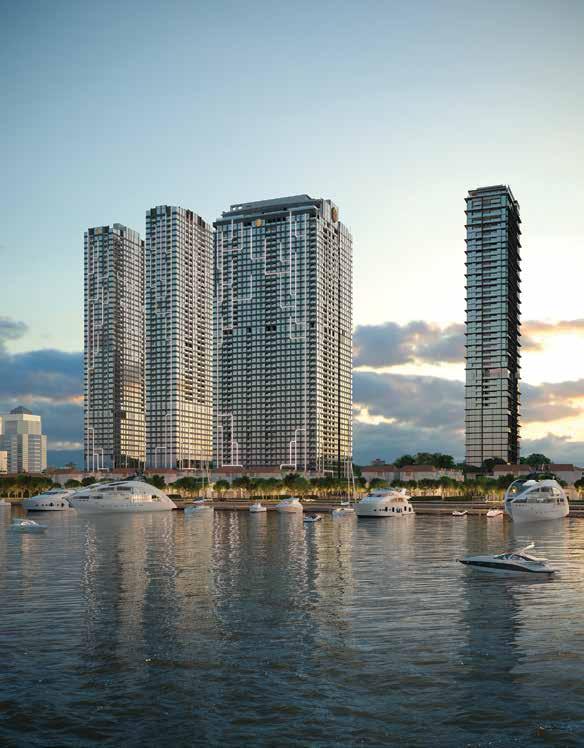
113
marriott residences grand marina , saigon & jw marriott residences grand marina saigon
LIST OF RESIDENCES
United States & Canada
arizona
The Ritz-Carlton Residences, Dove Mountain
The Ritz-Carlton Residences, Paradise Valley
british columbia
The Residences at the Westin Resort & Spa, Whistler
The Residences at the Westin Bear Mountain Victoria Golf Resort
california
The Residences at The St. Regis San Francisco
The Residences at The West Hollywood EDITION
The Residences at The Westin Monarche, Mammoth Lakes
The Residences at The Westin Verasa Napa
The Ritz-Carlton Residences, San Francisco
The Ritz-Carlton Residences, Los Angeles
The Ritz-Carlton Residences, Lake Tahoe
W Residences Hollywood
colorado
Beaver Creek Lodge, Autograph Collection Residences
The Residences at The Westin Riverfront Resort & Spa, Avon
The Ritz-Carlton Residences, Bachelor Gulch
The Ritz-Carlton Residences, Vail
The Sky Residences at W Aspen
district of columbia
The Ritz-Carlton Residences, Georgetown
The Ritz-Carlton Residences, Washington, D.C.
florida
JW Marriott Residences Clearwater Beach
The Residences at The Miami Beach EDITION
The Residences at The Tampa EDITION
The Residences at The St. Regis Bal Harbour
The Ritz-Carlton Residences, Bal Harbour
The Ritz-Carlton Residences, Coconut Grove
The Ritz-Carlton Residences, Fort Lauderdale
The Ritz-Carlton Residences, Key Biscayne
The Ritz-Carlton Residences, Miami Beach
The Ritz-Carlton Residences, Orlando, Grande Lakes
The Ritz-Carlton Residences, Sarasota
The Ritz-Carlton Residences, Singer Island
The Ritz-Carlton Residences, Sunny Isles Beach
W Residences Fort Lauderdale
W Residences South Beach
Waterline Marina, Autograph Collection Residences
georgia
The Ritz-Carlton Residences, Atlanta
The Residences at The St. Regis Atlanta
W Residences Atlanta — Downtown
hawai ‘ i
The Ritz-Carlton Residences, Kapalua
The Ritz-Carlton Residences, Waikīkī
Renaissance Residences Honolulu
illinois
The Ritz-Carlton Residences, Chicago
The Residences at The St. Regis Chicago
maryland
The Ritz-Carlton Residences, Baltimore
The Ritz-Carlton Residences, Chevy Chase
massachusetts
The Ritz-Carlton Residences, Boston Common
The St. Regis Residences, Boston
W Residences Boston
michigan
The Residences at The Westin Book Cadillac, Detroit
114
a story in herein shares a location with one or more of these residences
minnesota
The Residences at The Westin Edina Galleria
The Residences at Ivy, a Luxury Collection Hotel, Minneapolis
new jersey
W Residences Hoboken
new york
The Residences at The St. Regis New York
The Ritz-Carlton Residences, New York, Central Park
The Ritz-Carlton Residences, New York, NoMad
The Ritz-Carlton Residences, North Hills
The Ritz-Carlton Residences, Westchester
The St. Regis Residences, Rye
W Residences New York — Downtown
ontario
The Residences at The St. Regis Toronto Downtown
The Residences at The Westin Trillium House, Blue Mountain
The Ritz-Carlton Residences, Toronto
oregon
The Ritz-Carlton Residences, Portland
pennsylvania
The Ritz-Carlton Residences, Philadelphia
quebec
The Residences at Delta Hotels by Marriott, Beaupré
The Residences at the Westin, Mont-Tremblant
The Ritz-Carlton Residences, Montreal
texas
The Ritz-Carlton Residences, Dallas
W Residences Austin
W Residences Dallas — Victory
utah
The Residences at The St. Regis Deer Valley
virginia
The Residences at The Westin Virginia Beach
coming soon
New locations opening between 2024 to 2026
california
Beverly Hills
Santa Ana
florida
Longboat Key
Miami
Naples
North Fort Myers
Pompano Beach
Sarasota Bay
Tampa
West Palm Beach
georgia
Savannah
massachusetts
Boston
ohio
Cleveland
tennessee
Nashville
utah
St. George
virginia
Reston
Learn more at marriottresidences.com
LIST OF RESIDENCES
International
belize
Alaia Belize, Autograph Collection Residences
bermuda
The Residences at The St. Regis Bermuda
brazil
The Hotel Condominium Residences at the Sheraton Vitoria Hotel
british virgin islands
Scrub Island, Autograph Collection Residences
The Hotel Condominium Residences at the Sheraton Vitoria Hotel
cayman islands
The Ritz-Carlton Residences, Grand Cayman
china
Bulgari Residences Beijing
Bulgari Residences Shanghai
The Ritz-Carlton Residences, Guangzhou
W Residences Guangzhou
costa rica
W Residences Costa Rica — Reserva Conchal
dominican republic
The Residences at The Ocean Club, a Luxury Collection Resort, Costa Norte
greece
The Residences at The Westin Resort, Costa Navarino
indonesia
The Residences at The St. Regis Bali
Bulgari Residences Bali
The Residences at The St. Regis Jakarta
W Residences Bali — Seminyak
israel
The Residences at Jaffa, a Luxury Collection Hotel, Tel Aviv
The Ritz-Carlton Residences, Herzliya
jordan
The Residences at The St. Regis Amman
The Ritz-Carlton Residences, Amman
W Residences Amman
kazakhstan
The Ritz-Carlton Residences, Almaty
The Ritz-Carlton Residences, Astana
malaysia
The Ritz-Carlton Residences, Kuala Lumpur
The Residences at The St. Regis Kuala Lumpur
Marriott Residences Penang
mexico
Zadun, a Ritz-Carlton Reserve Residence
The Residences at Solaz, a Luxury Collection Resort, Los Cabos
The Ritz-Carlton Residences, Mexico City
The Residences at The St. Regis Kanai Resort, Riviera Maya
The Residences at The St. Regis Los Cabos
philippines
The Residences at Westin Manila Sonata Place
The Residences at Sheraton Cebu Mactan Resort
portugal
The Residences at the Pine Cliffs Ocean Suites, A Luxury Collection Resort
The Residences at Sheraton Cascais Resort
W Residences Algarve
puerto rico
The Residences at The St. Regis Bahia Beach Resort
Dorado Beach, a Ritz-Carlton Reserve Residence
qatar
The Residences at The St. Regis Marsa Arabia Island, The Pearl Qatar
116
marriott branded residences are not owned , developed or sold by marriott international , inc or its affiliates (“ marriott ”)
a story in herein shares a location with one or more of these residences
singapore
The Residences at The St. Regis Singapore W Residences Singapore, Sentosa Cove
The Ritz-Carlton Residences, Singapore Cairnhill
south korea
Marriott Residences Daegu
JW Marriott Residences Jeju
thailand
The Residences at St. Regis Bangkok
The Ritz-Carlton Residences, Bangkok
turkey
The Ritz-Carlton Residences, Bodrum, Epique Island
Le Méridien Residences, Bodrum
JW Marriott Residences Istanbul Marmara Sea
The Residences at Caresse Residences, a Luxury Collection Resort & Spa
The Residences at the Sheraton Istanbul Esenyurt
The Ritz-Carlton Residences, Istanbul
turks & caicos
The Ritz-Carlton Residences, Turks & Caicos, Grace Bay
united arab emirates
Bulgari Residences Dubai
The St. Regis Residences, Dubai
W Residences Dubai — The Palm
united kingdom
Bvlgari Residences Knightsbridge W Residences London
The Residences at the Westin London City
vietnam
Marriott Residences Grand Marina, Saigon
virgin islands ( british )
Scrub Island Resort, Autograph Collection Residences
coming soon
New locations opening between 2024 to 2026
bahamas Eleuthera
belize
Ambergris Caye
brazil
Gramado
Rio de Janeiro
Sao Paulo
costa rica
El Mangroove Papagayo
cyprus
Limassol
dominica Portsmouth
dominican
republic
Cap Cana
egypt
Cairo
guyana Georgetown
jamaica
St. Thomas
kazakhstan Astana
mexico
Cancun
Costa Mujeres
Los Cabos
Nayarit
Puerto Vallarta
Riviera Maya
morocco
Marrakech
oman Muscat
portugal Lagos
puerto rico San Juan
qatar Doha
saudi arabia Red Sea Riyadh
serbia Belgrade turkey
Istanbul
turks and caicos islands
Providenciales
united arab emirates Dubai
united kingdom London
vietnam Hanoi
Ho Chi Minh City Danang
Learn more at marriottresidences.com
Well and Good
The newest Marriott Residences are focused on creating idyllic havens for sustainable living in luxurious settings. From Dubai to Utah, here are some notable properties where nature is the main inspiration for the architectural narrative, creating distinct experiences for Owners.
Heralded as one of the most innovative residential projects promoting well-being in the Middle East, The Ritz-Carlton Residences Dubai, Creekside provides Owners with serene waterfront views of a nearby wildlife sanctuary; eight sustainable and organic-focused retail spaces, including a weekend farmer’s market; a private members only clubhouse with over three health-focused Michelin-star restaurants; a wellness center with multiple yoga and fitness rooms, indoor pools, rejuvenation and detox facilities; and a private boat dock for up to 120-foot yachts. The selection of mansions, penthouses and residences adhere to the WELL Certification Standards.
Living a well-balanced life is the cornerstone of the Westin brand and the first Westinbranded homes in Southeast Asia have made their debut in the Philippines with The Residences at The Westin Manila Sonata Place located in the heart of Ortigas Center Business District. Owners of the 344 residences benefit from access to signature offerings like the Westin WORKOUT fitness center, Westin Heavenly Bed, In-Residence Heavenly Spa by Westin, and the Move Studio where Owners may book their yoga and pilates sessions. Residents are also encouraged to join the RunWESTIN concierge and order healthy food and
beverage options from the exclusive Eat Well menu for In-Residences Dining.
Inspired by the principles of mindfulness and the world’s natural beauty, JW Marriott Residences Jeju include 75 homes co-located with the hotel, perched on a rugged cliffside overlooking the dramatic volcanic coastline of the South Korean island. A signature JW Garden and Serene Spaces are rooted in nature to let Owners focus on being present, and nourish the body and spirit while celebrating the magnificence of the natural surroundings. Master planned to honor its adjacency to a national park, historic trails, and a natural stream flowing through the site, the Jeju resort’s landscaping is a harmonious fusion of nature and architecture complete with low lava stone walls and mustard flowers that bloom in a sea of yellow, a lucky color in Korea.
Offering a balance of wellness and adventure, connectivity and sustainability, Atara, Autograph Collection Residences , in St. George, Utah, are located within Desert Color, southern Utah’s premier 3,400-acre master-planned community. Atara’s 136 one- to four-bedroom villas are designed to echo the textures and palette of the surrounding mountains, sky, and sand. The 14-acre resort serves as an ideal location to explore the area, and go hiking, biking, or hit one of 13 resort and championship golf courses. A specialized concierge service can help plan visits and adventure trips to five internationally famous national parks, the Grand Canyon, Zion, and Snow Mountain Canyon.
dubai / manila / jeju / utah
featured properties
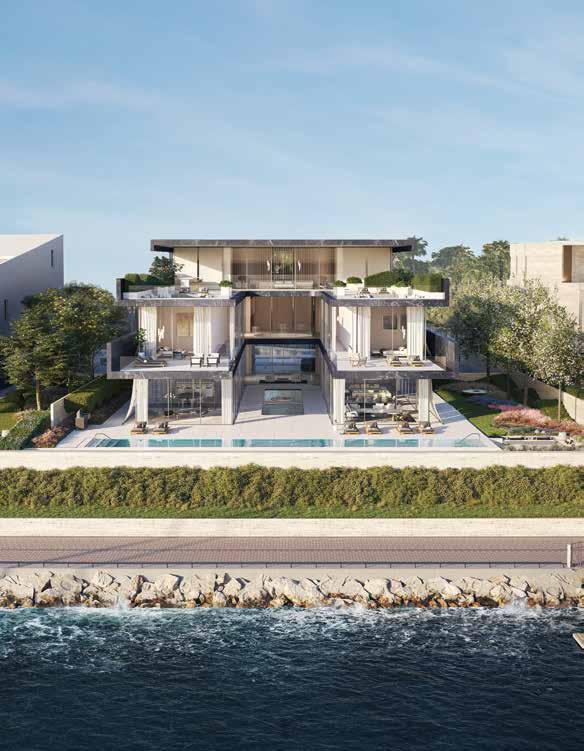
119
mansion at the ritz - carlton residences , dubai , creekside
Joy of Ownership
When Lionheart Capital announced plans to offer Ritz-Carlton branded residences designed by famed Italian architect Piero Lissoni in Miami, the project instantly caught Bruce Starr’s attention.
The founding partner and CEO of BMF, a full service marketing agency that works closely with Marriott International’s luxury brands on activations and events, had already been seeking a new home in Miami with his husband David, who runs real estate for Gucci Americas, and their two long-haired dachshunds Margiela and Rumor.
“We had been fans of Piero Lissoni for a long time, and had even attended events at the sales office for the project, but this was all
before we had decided on moving full-time to Miami,” Bruce says.
Located on a quiet corner in one of South Florida’s most affluent neighborhoods on the shores of Surprise Lake, the eight-story Ritz-Carlton Residences in Miami Beach opened in 2019. The redeveloped former hospital complex has 111 condominiums and 15 stand-alone villas. Amenities include elevated fitness, spa and dining options across immaculate grounds, as well as 36 private moorings for boat owners, and a residential art studio.
There’s certainly a lot to love. Lissoni’s Italianinspired minimalist aesthetic pairs perfectly with Florida’s penchant for open floorplans with clean lines and light-toned interiors that create a sandy serenity only enhanced
text
images
by marc graser
by laura randall
incorporating the excitement of the city is part of the design story for bruce and david starr at the ritz - carlton residences , miami beach

121


by expansive floor-to-ceiling windows, sleek woods and shiny metal surfaces.
The structure is meant to resemble a tall tower that’s been developed horizontally, with cantilevered terraces and canopies that blend in seamlessly with the surrounding landscape and waterfront.
The residence’s amenities and location close to restaurants and shops in the Design District, Bal Harbour, South Beach and Sunset Harbour were big draws for Bruce and David. Yet, while Lissoni’s understated design touches were represented in the home they purchased, Bruce and David felt something was missing—their own personal touch.
“Our goal was to make it feel like home for us,” Bruce says. “We were used to building our last condo from the ground up, just the way we wanted, and with this unit we moved into something finished. While it was luxury,
it also felt like it was never customized for the owner.”
The couple updated every room in the three-bedroom home. They wanted to make smarter use of the square footage, flipping the location of the powder room and expanding the laundry room to turn it into a proper mud room, for example.
After gutting a condo in New York City, Bruce and David “knew the drill and took our time, coming fully prepared with all elements for the construction team, which then made the process go as quickly as possible, as we had everything chosen, bought, delivered, and ready to go.”
The final design of the two-story condo is vibrant, bold and eclectic, reflecting Miami’s unique culture and climate. It’s contemporary with pops of pink, bright yellow, and greens to inject some Miami fun.
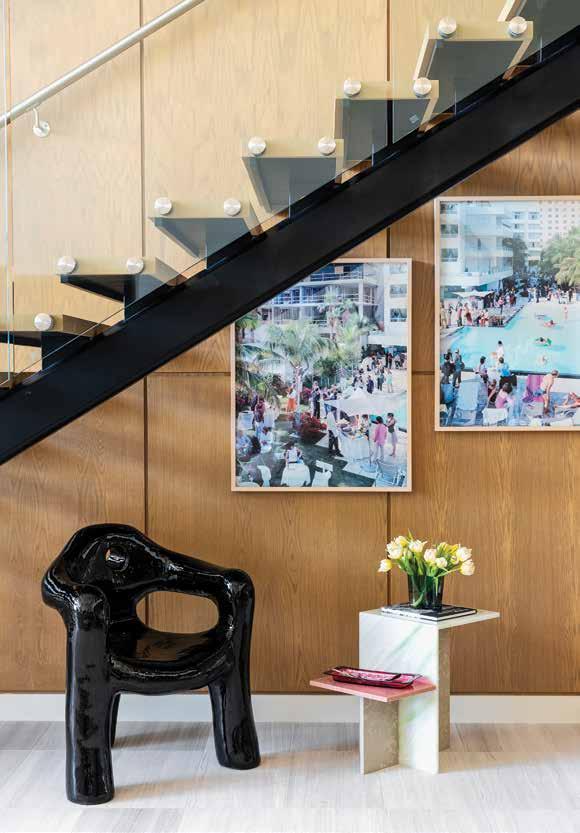
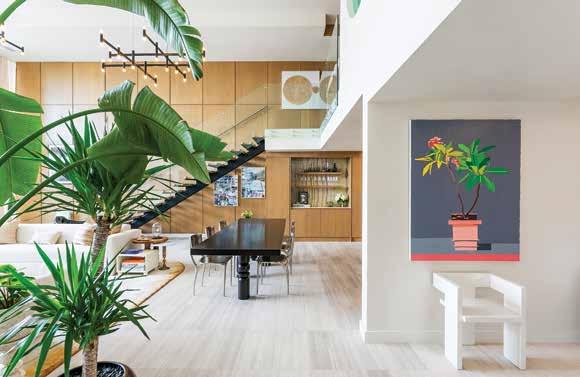
The living space is an open floorplan that’s bright and airy, with 25-foot ceilings that invites natural light to flow freely. Large palms were brought in to fill the space with greenery to make it feel more alive.
While Miami is part of the design story, it’s not the entire story.
“The feeling of place is definitely important, but it’s not a style,” Bruce says. “For us the home needs to reflect the family that lives within.”
That meant covering walls with venetian plaster to help create a warm reflective feeling and glow against newly wood-covered walls to create a more inviting atmosphere.
Some of the couple’s favorite design elements are the Ann Sacks fluted marble terrazzo, as well as a Zieta Studio mirror, and Ramsey Conder hardware in the powder room.
“The custom bar with onyx backsplash and counter is something I’m super proud of that we designed as well,” Bruce says.
Another signature Miami element is the display of abstract art pieces that evoke the city’s energy and excitement. Bruce and David’s impressive art collection is perfectly displayed throughout the home, but not in a way that makes its sleek walls feel like an art gallery.
On display in the powder room is a rare collage from American photographer Ryan Mcginley. It’s a piece Bruce actually previously purchased at Art Basel in Miami years earlier.
Another piece in the hallway is by painter Guy Yanai, which he created for the couple’s wedding and was unveiled in Tel Aviv at their rehearsal dinner. “It’s super meaningful for us,” Bruce says.

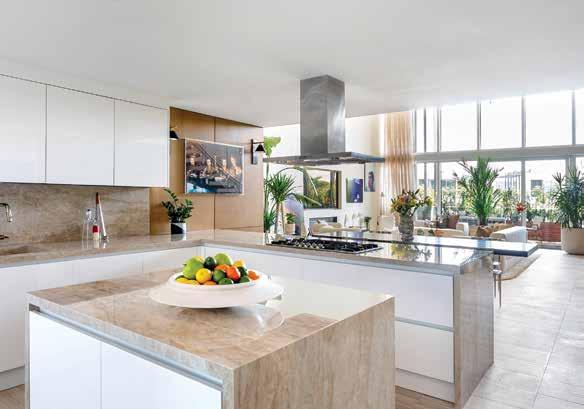
Bruce’s favorite space in the home is the great room, which also displays the couple’s collection of whimsical modern furniture and art pieces.
“Its sheer size and height are what sold us on the unit,” Bruce says. “There’s something super special about having a giant space like that to entertain, host, and feel super connected.”
With the renovation complete, the couple is enjoying settling into their new home—as are their dachshunds.
“They have their favorite places to rest, be it in one of the walk-in closets, behind the couch, or in their new bed under the stairs,” Bruce says. “It’s amazing to see them run through the great room to play, or tap on the door to sunbathe on the balcony.
“We really focused on building this home not only for the two of us, but with our family in mind, meaning the dogs, future kids, and extended family that lives in Miami, and comes over frequently as we love to host,” Bruce adds. “We wanted a space we could grow into, and host shabbats and entertain for the holidays, and to create a place we rarely want to leave.”
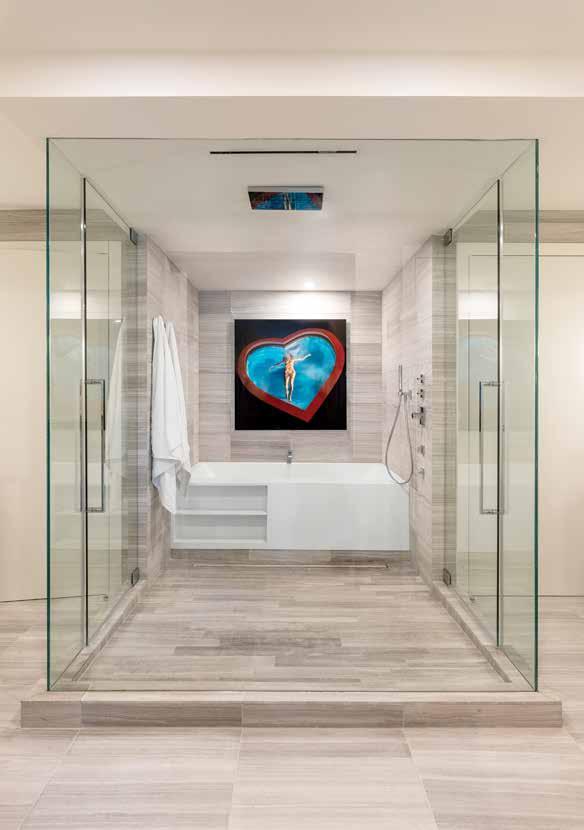

































 text by winston ross images by tim aukshunas
text by winston ross images by tim aukshunas



















 text by josh terry
text by josh terry




































 text by sowmya krishnamurthy
text by sowmya krishnamurthy























 the museum of islamic art in doha , qatar
the museum of islamic art in doha , qatar

















